2023_149
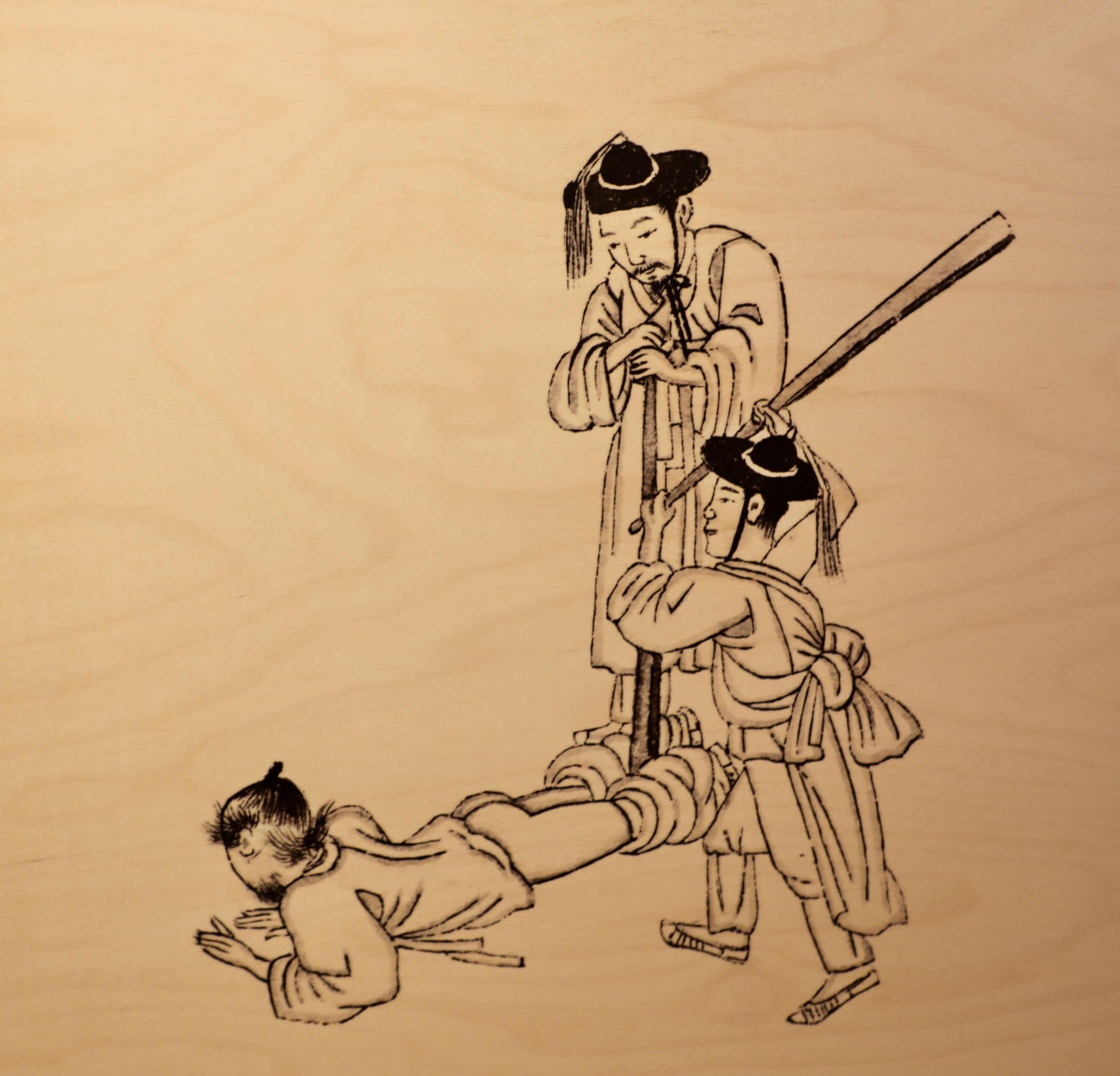
2023. 9. 19. (화) 오후에 관람
지난 7월, 처음으로 서울 한양도성을 순성 할 때는 오직 한양도성에만 신경을 썼다.
낙산공원을 지날 때 제법 멋지게 생긴 건물이 궁금했지만 그냥 지나갔다.
이번엔 한양도성 주변의 여러 곳에 한양도성과 관련된 박물관이나 전시관이 있다는 걸 알았다.
그중에 하나가 바로 서울디자인센터 건물에 있는 「한양도성 박물관」이다.
「한양도성 박물관」은 1, 2, 3층을 절반 정도 차지하지만, 한양도성 관련 유물은 많지 않다.
직접적으로 성벽에서 전쟁이 치러지지 않는 한 발견되는 유물은 그리 크지 않다.
그런 까닭에 이 박물관은 한양도성의 축조과정이나 가치 · 관리 · 복원 등에 대한 자료의 제공이 많다.
이런 자료를 읽어 보면 서울 한양도성에 대한 심도 있는 이해가 가능하다.

서울디자인센터로 내려가는 길은 성벽을 따라 이 건물 뒤로 뒤로 내려가 건물을 끼고도는 게 더 빠르다.
그전에 나무가 보이는 곳에서 내려가면 훨씬 많아 돌아야 한다.
한양도성 박물관의 내용은 안내문을 카피하는 것으로 대신한다.
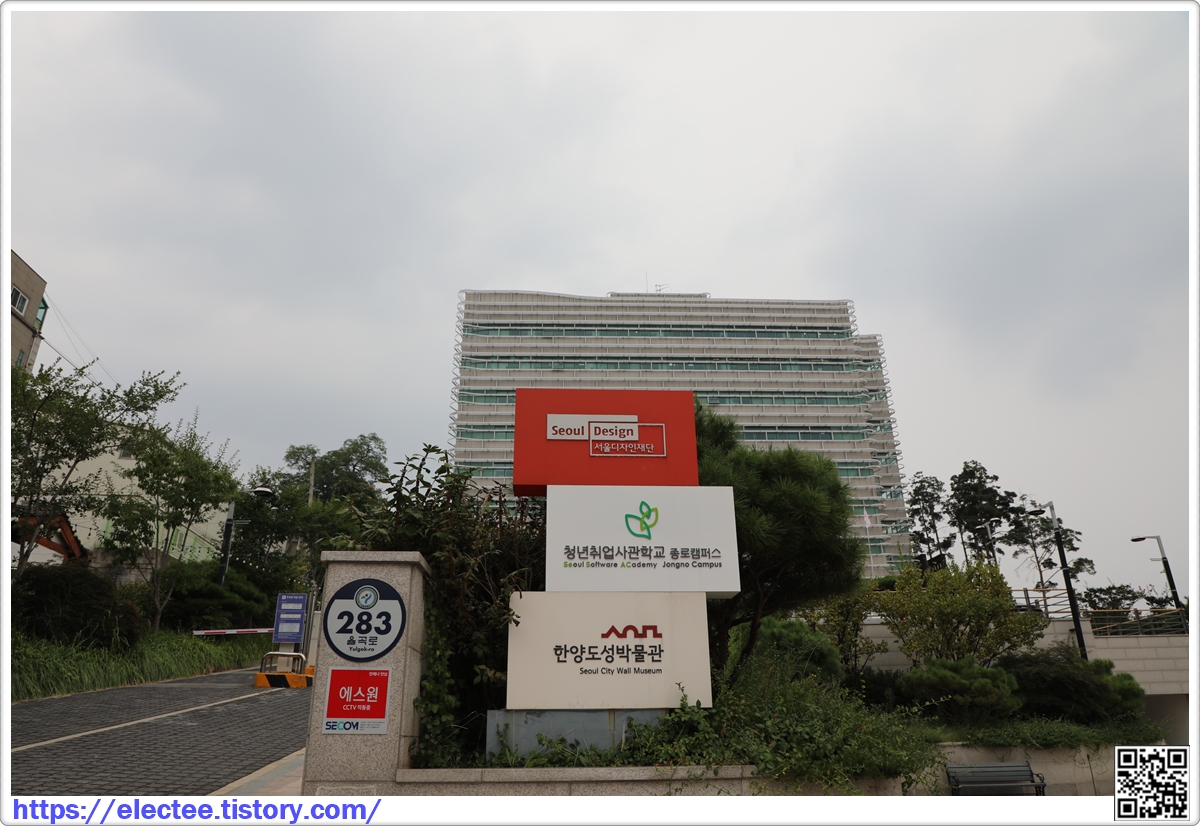
수도 한양의 시작. The Process of Establishing Hanyang as the Capital
조선 건국과 한양 천도 Founding the Joseon Dynasty and Establishing the Capital at Hanyang
1392년 음력 7월, 이성계를 중심으로 하는 일단의 무장과 관료들이 고려 왕조를 멸망시키고 새 왕조를
개창하였다.
그 직후 새 왕은 도평의사에 한양으로 도읍을 옮기라고 명하였다.
반대하는 이들이 적지 않았으나 왕은 '예로부터 새 왕조를 개창한 뒤에는 반드시 도읍을 옮겼다'라고 강경히
주장하여 그 뜻을 관철시켰다.
이에 곧바로 천도를 단행하였지만, 궁궐과 성벽이 없는 곳에서 정무를 처리할 수는 없었기에 곧 개경으로
환도하였다.
이후 2년여간 여러 군데의 후보지를 두고 새 도읍의 적지원한 를 물색한 끝에 한양보다 나은 곳이 없다는
결론이 내려졌다.
한양은 풍수지리설로 보아 명당일 뿐 아니라 국토의 중앙부에 있어 행정력을 남·북 변방에 고루 미칠 수 있으며
지류가 발달한 한강에 면해 조운이 편리하였다
1394년(태조 3) 10월 25일, 조선왕조는 한양으로 천도를 단행하고 도성 건설 공사를 본격화하였다.
In the 7th month of 1392, King Taejo founded a new dynasty.
Various candidate sites for the new capital were nominated over the next two-plus years,
but in the end none were deemed to be better than Hanyang.
In geomantic terms, Hanyang was the most ideal propitious site.
Moreover, Hanyang was located about halfway down the Korean Peninsula,
near the mouth of the Hangang (River).
Thus accessibility to all parts of the country was well balanced, and shipping cargo via
the Hangang was convenient.
The Joseon founder-king had the capital officially relocated to Hanyang on the 25th day
of the 10th month in 1394, and construction work on the capital facilities began in earnest.
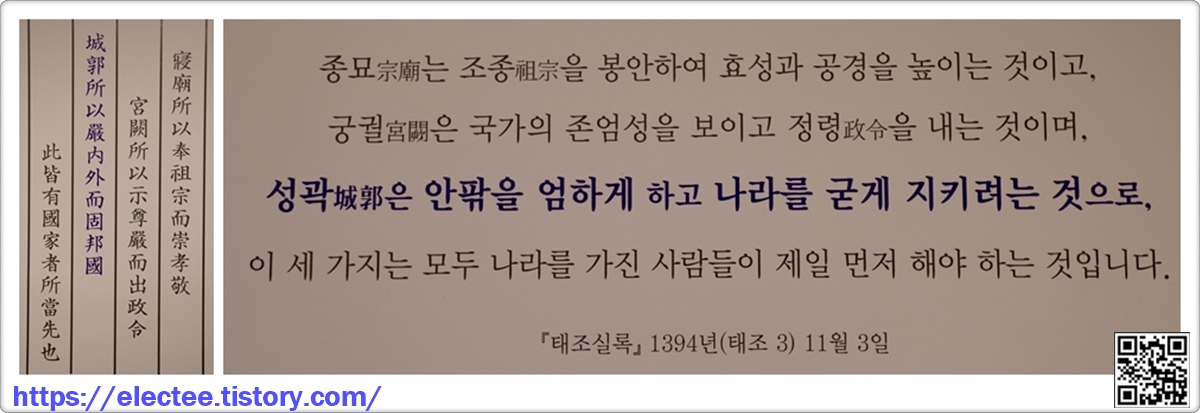
『태조실록」 1394년(태조 3) 11월 3일
The Royal Ancestral Shrine is where the [spirit tablets of the royal] ancestors are enshrined,
and filial piety and reverence are exhorted.
The Royal Palace is where the solemn authority of the state is displayed, and the affairs of state are carried out.
The City Wall is where the [boundary between] inside and outside the capital is carefully guarded,
and the state is secured.
These are all priorities for the rulers of the state. Annals of Taejo, 3rd day of 11th month, 1394
서울, 한양도성 漢陽都城 Seoul, Hanyangdoseong
인구 1천만 명, 면적 605㎢의 거대 도시 서울은 매일매일 변화하는 새로움의 연속체이다.
해가 뜨고 서울의 하루가 시작되면 많은 사람들이 바쁘게 움직이고 도시는 빠르게 변화한다.
그러나 이것이 서울의 전부는 아니다.
서울은 600년 두터운 과거가 오늘의 일상과 함께 공존하는 역사문화도시로서,
오래도록 도시의 역사와 궤를 같이 해온 한양도성이 이를 증명한다.
1396년 조선의 수도 서울(한양)에 건설된 한양도성은 도시의 경계이자 도성민의 삶을 지키던 울타리였다.
근대화 과정에서 도성의 기능은 없어지고 망각 속에서 제 모습을 상당 부분 잃어버린 채 우리 곁에서
멀어졌지만 한양도성은 여전히 서울의 중심에 자리하고 있다.
발굴과 복원을 통해 현대에 되살아나고 있는 한양도성은 사계절과 밤낮의 변화를 거듭하며 지금도
도성 안 서울 사람들을 품고 있다.
Seoul today is a major metropolis with a population of ten million and an area of 605㎢.
This is a historical city with a rich legacy that goes back more than six centuries and the Hanyangdoseong,
a treasure trove of city history, stands as proof of this.
The original purpose of the city wall vanished in the process of modernization.
It grew distant from people's lives but remained in the heart of the city.
Through excavation and reconstruction, the wall has been revived in recent times, its appearance
ever changing with the seasons and time of day.
Today the city wall stands tall, embracing the residents of the capital.
有一千万名人口, 605平方公里面积的庞大城市首尔, 是日日蜕变的崭新连续体。
随着旭日的东升, 开启了首尔的一天, 很多市民忙碌的生活, 快速地改变了城市的面貌, 但这不是首尔的全部。
首尔共存着600年深厚的历史与今日的日常, 是历史文化城市,
很长时间与城市历史并轨的汉阳都城就可以证明这一切。
1396年在朝鲜王朝的首都首尔(汉阳)建造的汉阳都城是城市的境界线, 也是守护都城居民生活的护栏。
都城在近代化过程中已丧失了其功能, 也被人们遗忘, 原貌的相当部分已流失, 并渐渐地远离了我们,
但是汉阳都城仍然矗立于首尔的中心。
通过挖掘与复原, 在现代重现生机的汉阳都城, 反复着四季与昼夜的支化, 目前仍然在城内怀抱着首尔的人们。

도성이 서울이다 Doseong is Seoul
자본주의 산업화 이전의 도시들은 대개 성벽으로 둘러싸여 있었다.
인류가 수천 년 전부터 지표상의 특정 공간을 성벽으로 둘러싼 것은 성벽 안쪽이 특별한 기능과 상징성을 가진
영역임을 표시하고, 그 영역을 외부의 공격으로부터 방어하기 위해서였다.
이런 맥락에서 한양도성을 처음 축조할 때 도평의사사에서도
"성곽은 안팎의 경계를 엄격히 하고 나라를 굳건히 지키기 위한 것"이라고 했다.
도성이란 왕이 거처하는 성으로서 여러 성 중에서 으뜸가는 성, 곧 모든 국가 기능이 집중된 수도를 의미한다.
순우리말 '서울'은 수도라는 뜻이니, 도성이 곧 서울이었다.
서울은 도성 안의 국가 중추 기능을 보존한 채 성벽을 넘어 현대 도시로 팽창했다.
현재의 한양도성은 국제도시 서울의 역사를 증언하는 문화유산이다.
The world's preindustrial cities typically were surrounded by walls.
For thousands of years, people would mark out specific sites on the earth's surface by building walls
around them.
The walls indicated that a domain with special functions and symbolism was inside,
and they stood to protect that domain from external attack.
Doseong refers to the walled city in which the ruler once resided.
It was the foremost among all the walled cities in the country, the capital, where all the maior state
functions are concentrated.
The native Korean word for "doseong" is "Seoul" Hence, the Korean capital is now called Seoul,
a modern metropolis that has expanded beyond the confines of the old city walls.
The Hanyangdoseong today is a cultural heritage that attests to the history of Seoul,
a major international city.
한양도성의 가치 The Value of the Hanyangdoseong
한국인들은 고대부터 산의 능선에 성을 쌓는 촉성 문화를 발전시켜 왔다.
한양도성은 이를 계승하여 자연에 대한 개입을 최소화하면서도 위엄과 효율을 극대화했다.
도시의 외곽선이 자연의 선형에 따라 결정되었기 때문에, 내부의 가로 체계와 도시 구조도
자연의 형상과 조화를 이루었다.
이는 대로를 중심으로 인위적이며 기하학적인 도로망을 형성한 동시대 아시아 도시들과 확연히 다른 점이다.
한양도성은 다양한 지형과 지질에 따라 서로 다른 축성 기법을 사용했으며 무너진 구간을 보수할 때마다
진전된 기술을 도입했으니, 한국 축성 기술의 발전 과정을 아로새긴 문화유산이다.
또 출입, 보수, 관리, 순찰 등과 관련한 노동, 놀이, 예술의 배경이자 무대이기도 했다.
서울이 팽창하기 시작한 뒤 성벽 주변에 생긴 마을들은 오래된 문화유산과 공존하는 현대적 생활양식을 보여준다.
Since ancient times, Koreans have developed a tradition of building city walls along mountain ridges.
The Hanyangdoseong is a continuation of this tradition, which minimizes the disturbance of the natural
surroundings and maximizes the stateliness and effectiveness of the structure.
The contour of the city wall followed the lay of the land, and so the street system and urban layout inside
the wall also was in harmony with the natural forms.
This clearly differed from most other Asian cities of that period.
The Hanyangdoseong was built using a variety of methods, depending on geographical features.
Each time a collapsed section was repaired, more advanced techniques were employed,
so the Hanyangdoseong stands as a cultural heritage that traces the development of Korean wall
building technology.
도성 조영의 원리 Principles for Building a Capital
북한산과 한강 사이의 한양은 고려시대부터 삼한 제일의 명당으로 꼽혔다.
한반도를 남북으로 가로지르는 백두대간의 중반부에서 지맥이 갈라져 서쪽으로 치닫다가 우뚝 솟아
북한산을 이루었으며, 그 남쪽의 지맥이 백악습동으로 이어졌다.
백악은 남쪽으로 목멱을 마주 보고 동쪽의 낙산, 서쪽의 인왕산과 함께 널찍한 평지를 감쌌다.
네 개의 산으로 둘러싸인 평지 한가운데를 관통하는 하천이 서에서 동으로 흐르고,
목멱 남쪽의 한강은 동에서 서로 흐른다.
조선왕조는 내사산의 능선을 따라 성벽을 쌓아 도성의 외형과 크기를 정했고,
그 내부의 시설 배치는 유교 경전의 하나인 「주례」, 「고공기」의 원리를 준용하였다.
백악 앞에 궁궐을 지었고 그 좌측에 종묘, 우측에 사직을 배치했으며 궁궐 앞 대로에는 주요 관청을,
도성 내부를 관통하는 '丁' 자형 대로 좌우에는 시전市廛을 조성하였다.
Hanyang is situated between Bukhansan (Mountain) and the Hangang (River),
and according to geomantic theory, the site is the most propitious on the Korean Peninsula.
Baegaksan (Mountain) is connected to Inwangsan (Mountain) to the west and Naksan (Mountain)
to the east while facing Mongmyeoksan (Namsan Mountain) to the south.
A broad plain is thus surrounded by mountains and has a stream (Cheonggyecheon) flowing across it,
from west to east. South of Mongmyeoksan, the Hangang flows east to west.
The Joseon dynasty founders had a wall built along the ridgelines of these four inner mountains
that surrounded the Hanyang site.
The wall defined the configuration and size of the capital city, while the internal layout corresponded
with the principles stipulated in the Rites of Zhou, a Confucian classic
도성 축조와 인력의 운영 Constructing the Wall and Managing the Workforce
도감과 군문 Directorates and Army Commands
1395년(태조 4) 음력 윤 9월, 도성 축조를 전담하는 기관으로 도성조축도감都城造築都監이 설치되었다.
도감이란 국가적 행사나 공사 등의 한시적 목적 사업을 위해 설치되었다가 일이 끝나면 해체되는 임시
기구에 붙는 이름이었다.
고려시대 도감의 일반 직제대로 구성했으며, 97개로 나뉜 공사 구간 두 곳당 한 명씩 현장감독 격인
감역監役을 배치하였다.
1398년(태조 7) 숭례문 역사가 끝난 뒤 해체 되었다.
세종 때의 공사는 1421년(세종 3) 음력 10월에 설치된 도성수축 도감이 관장하였다.
도성수축 도감 역시 수리와 개축 공사가 끝난 뒤 해체되었고,
대신 1426년(세종 8)에 수성금화도감修城禁火都監이 신설되어 성벽 수리와 방화 업무를 겸하였다.
숙종 때에는 따로 도감을 설치하지 않고, 각 성벽 구간의 수비를 맡은 군문軍門에서 공사를 관장하였다.
The Office of Capital City Wall Construction was established in the 9th intercalary month of 1395.
The directorate dispatched supervisory officials who were each responsible for overseeing two of the 97
sections into which the capital wall was divided. It was abolished after the Sungnyemun construction
project was completed in 1398.
The Office of Capital City Wall Repair was then formed in the 10th month of 1421 to oversee wall
construction and repair work undertaken during the reign of King Sejong (r.1418-50).
Separate directorates were not organized for wall-related projects in the time of King Sukjong (r.1674-1720).
Instead, the Three Army Commands in the capital were each assigned their own section of the city wall t
o guard and they were also responsible for overseeing any construction or repair work performed in their
respective sections.
한양도성을 쌓은 사람들
중세 사회에서 양인은 국가에 조세, 공물, 요역을 바쳐야 했다.
양인은 사대부와 천민을 제외한 자유민으로서 국가는 이들의 노동력에 의존해 유지되었다.
조세는 수확한 농작물의 일부를 바치는 것, 공물은 지역 특산물을 바치는 것,
요역은 노동력을 직접 제공하는 것이다.
요역 중 대표적인 것이 군역이었지만, 길을 닦는 치도역, 성을 쌓는 축성역 등도 종종 부과되었다.
한양도성 축성은 전국의 양인들에 대한 중앙정부의 통제력을 점검하는 계기이기도 했다.
1396년(태조 5)에는 경상, 전라, 강원과 국경 인근 지역을 제외한 서북면과 동북면 양인들을
1차에 118,070명, 2차에 79,400명 동원하였다.
경기, 충청, 황해도 양인들은 궁궐 건설을 맡았다.
1422년(세종 4)에는 전국에서 322,460 명의 양인과 2,211명의 공장을 동원하였다.
1704년 (숙종 30) 이후의 도성 수축공사는 도성 내외 군문화의 병사들과 임금 노동자인 모군들이 담당하였다.
In medieval Korean society, the commoners were regularly required to pay taxes,
offer tribute and provide conscript labor to the state.
The conscript labor was mainly provided in the form of military service, but conscripts also were used
on large-scale construction projects to improve roads, build walls, and so on.
The construction of the Hanyang-doseong served as an opportunity for the central government
to ascertain the degree of its control over the common people.
The central government mobilized 197,470 commoners from around the country in 1396.
A total of 322,460 commoners and 2,211 craftsmen were mobilized in 1422.
From 1704 on however, soldiers from the army commands in the capital vicinity as well as paid laborers
were responsible for wall construction and repair work.
축성 준비 Preparations for Wall-building
농경사회에서 토목공사는 농한기인 겨울에 하는 일이었다.
그래서 토목공사를 담당하는 국가기관인 공조工曹를 '동관冬官'이라고도 하였다.
조선 정부는 겨울철 공사를 앞두고 먼저 각 지방관에게 일할 사람들을 뽑아 한양으로 올려 보내게 하였다.
그즈음 한양의 호구 수는 수천에 불과하였으니, 궁궐, 종묘, 사직 등의 영건물을 공사와 도성 축성 공사에
동원된 수십만 명의 인원을 수용할 시설이 있을 리 없었다.
본격적인 공사에 앞서 수십만 명 인부들의 먹을거리와 땔 거리를 조달하고 거처를 마련하는 일이 진행되었다.
세종 때에는 네 곳의 구료소도 설치하였다. 토석土石과 목재는 공사 현장 인근에서 조달하였다.
1448년(세종 30) 도성 내외의 산에서 채석採石을 일체 금지하였기 때문에 1704년(숙종 30)의 수축 공사 때에는
도성 밖 노원과 주암의 돌을 캐서 썼다.
하지만 공사가 지연되고 사상자가 많이 발생하여 곧 도성 인근의 구준봉狗蹲峰 밖 청수동, 사동, 불천佛川
근처, 창의문과 혜화문 주변 등으로 채석장을 확대하였다.
The government would have officials in the provinces select workers and send them to Hanyang.
Food, firewood and shelter for hundreds of thousands of people would have to be prepared
in advance of a large-scale construction project.
In Sejong's reign, medical treatment facilities were also set up in four locations.
The necessary earth, stone and wood for the project were gathered in the vicinity of the construction
sites for early projects, but quarrying rock from the hillsides inside or immediately outside the capital was
banned in 1448.
A major wall repair and restoration project was carried out in the early 18th century,
and the needed materials were initially quarried at Nowon and Juam, which were distant from the capital.
However, this caused work delays and caused many workers to be injured or even killed while
transporting he stone.
Therefore, the quarry sites were expanded to include areas closer to the city wall.

성 쌓기 Wall Construction
축성 공사는 성 쌓을 자리의 땅을 다지는 지정地定에서 시작된다.
바닥이 흙인 경우에는 땅을 깊이 파서 나무 말뚝을 박거나 잔돌을 넣어 다지고,
암반인 경우에는 돌이 미끄러지지 않도록 평평하게 다듬었다.
땅이 다져지면 바깥쪽으로 지댓돌을 놓았는데, 빗물에 파여 나가지 않도록 그 앞을 평평한 돌로 덮기도 했다.
지댓돌 위에 평평한 자연석이나 네모지게 가공한 돌들을 쌓아 올리고 그 뒤를 잔돌과 흙으로 채우는 공정을
반복하여 체성을 만들었다.
체성 위에는 여장女墻을 쌓고 옥개석을 덮었다.
축성 공사에서 큰 비중을 점한 것은 돌을 뜨는 채석과 돌을 다듬는 치석治石인데,
태조와 세종 때에는 공사장 인근에서 이 일들이 이루어졌으나 숙종 때에는 도성 밖 먼 곳에서 돌을 떠
산 능선까지 운반하는 고된 노동이 부가되었다.
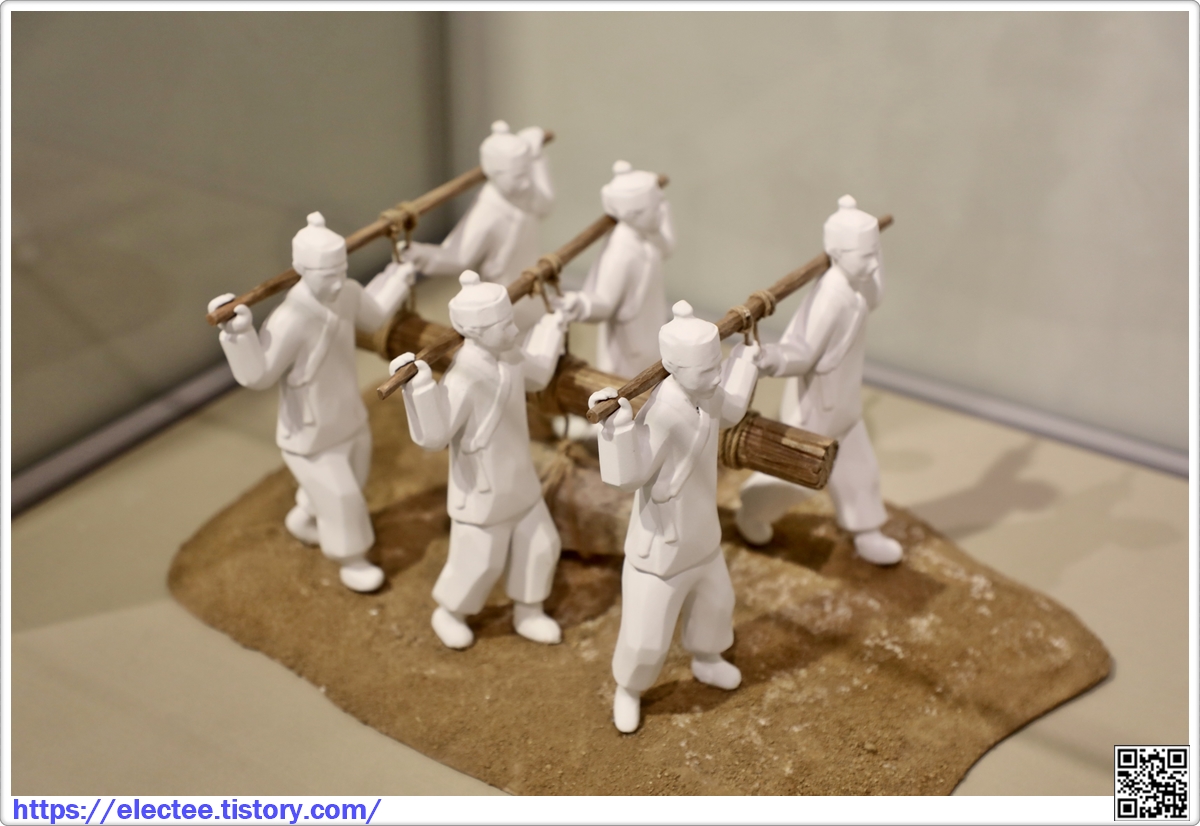
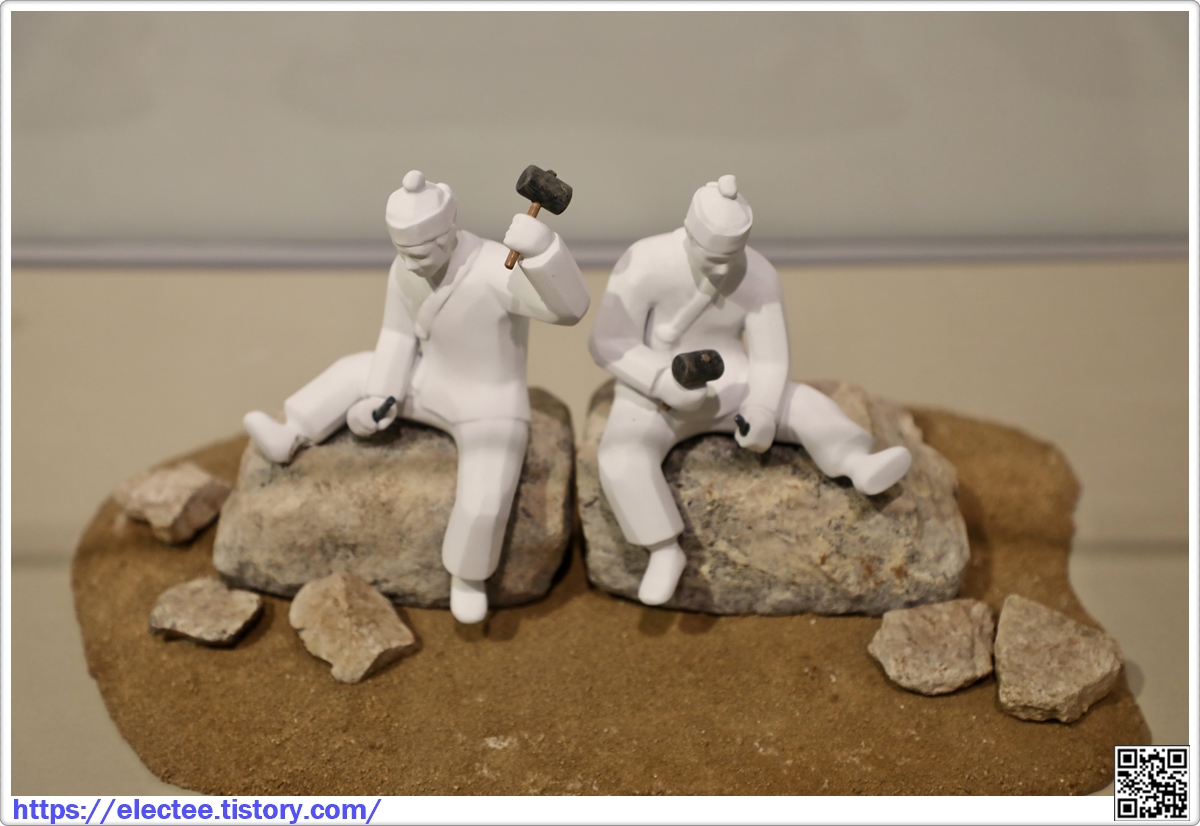
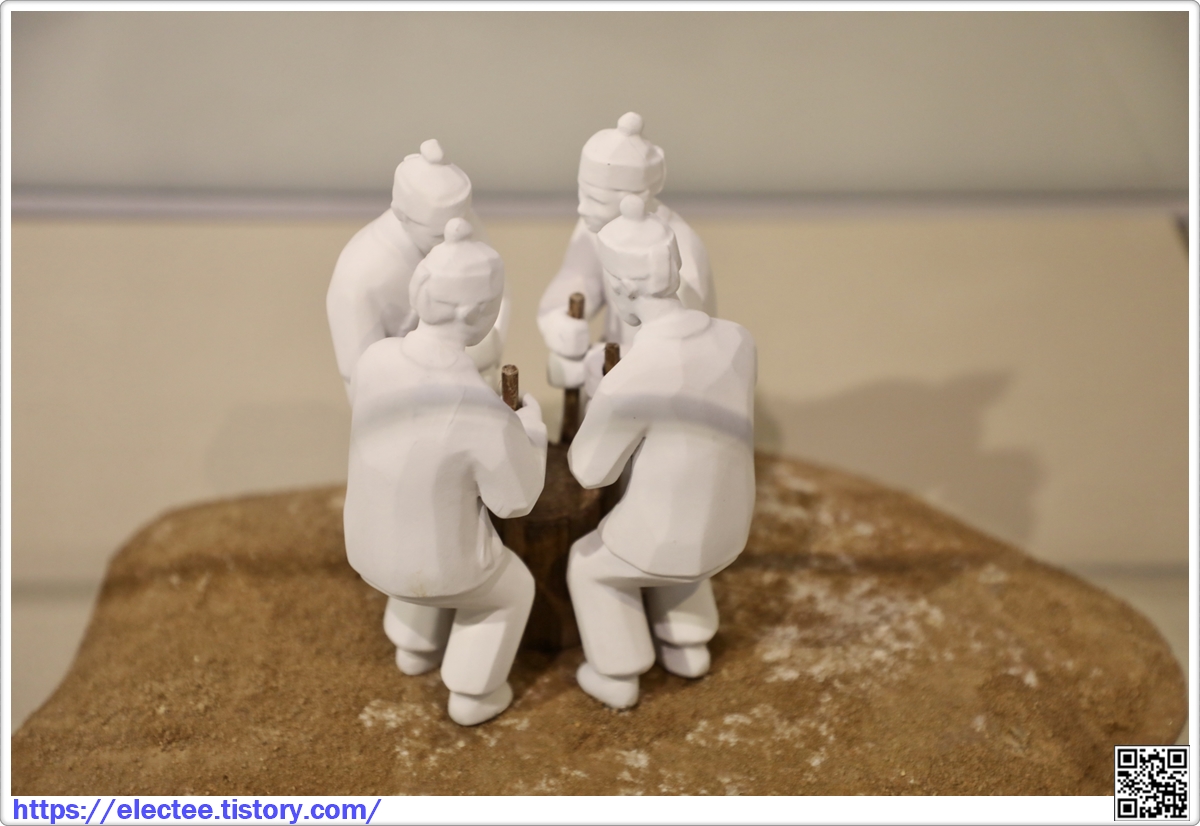
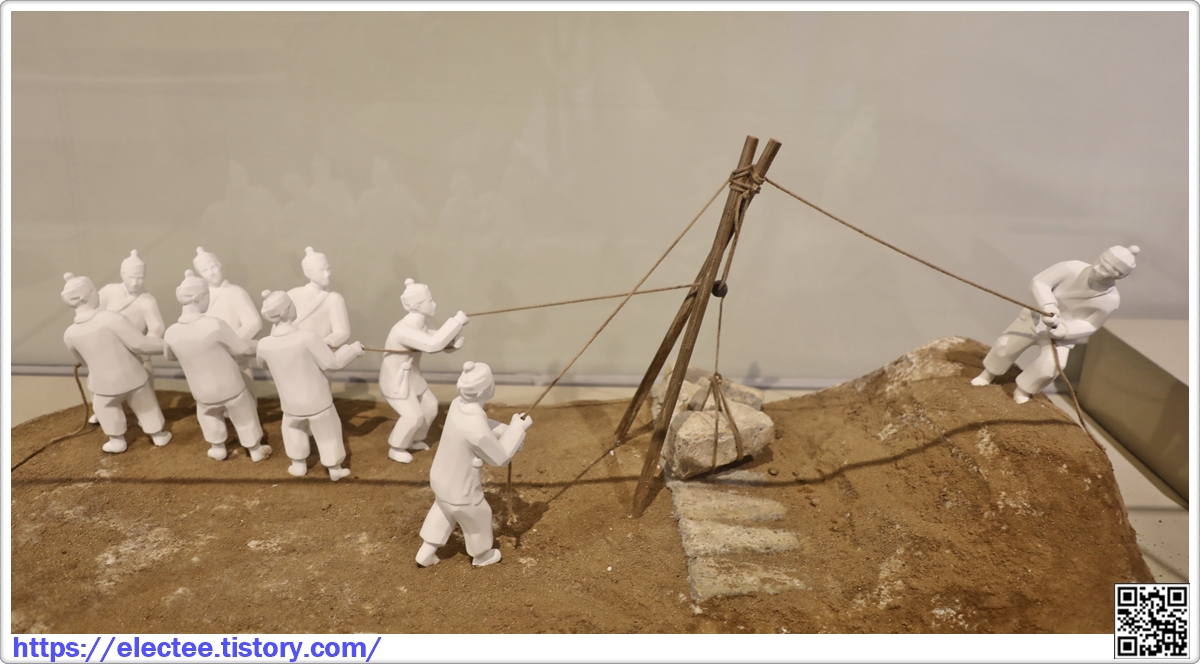
도성의 구조와 시설 Hanyangdoseong Structure and Facilities
성벽 The Wall
성벽은 몸통인 체성과 그 위에 낮게 쌓은 여장으로 구성된다.
체성은 다시 바깥쪽의 석축과 안쪽의 뒤채움으로 이루어진다.
석축은 뒤채움으로 쌓은 흙과 돌의 압력을 견딜 수 있도록 위로 올라가면서 안쪽으로 들여쌓아
상단부와 하단부 사이에 수직으로 1m 내외의 거리가 있다.
여첩女堞, 타垞, 성가퀴라고도 하는 여장은 성벽에 의지하여 몸을 보호하면서 적을 공격하기 위해 쌓은 시설이다.
성벽의 중간중간을 끊어 요철凹凸 모양으로 쌓았는데, 끊어진 곳을 타구 垞口라 하며,
타구와 타구 사이를 堞 또는 타라 한다.
세종대 쌓은 여장의 모양은 알 길이 없으나 숙종대 쌓은 여장은 주력 무기가 총으로 바뀐 것을 반영하여
총구멍을 내었다.
이를 총안銃眼이라 하는데 수평으로 낸 것은 먼 곳의 적을 공격하기 위한 원안, 아래쪽으로 기울여 낸 것은
가까운 곳의 적을 공격하기 위한 근총안이다.
도성의 문 The Capital Wall Gates
성문은 성벽으로 둘러싸인 특별한 공간과 그 외부 사이의 접촉을 통제하는 시설이다.
도성을 빠져나가는 사람이나 도성 안으로 들어오는 사람 모두 성문을 통해서만 출입할 수 있었고,
문을 여닫는 시각은 국가가 통제하였다.
한양 도성에는 8개의 문과 2개의 수문水門이 있는데, 동•서•남의 세 문은 유교의 덕목인 인의예지를 취해
흥인문, 돈의문, 숭례문이라 이름 지었으나 북문은 풍수지리설의 논리에 따라 숙청문이라 하였다.
흥인문은 후에 흥인지문이 되었고, 숙청문은 숙정문으로 바뀌었다.
흥인지문과 숭례문은 석축 위에 2층 문루를 지어 대문의 격식을 갖추었고, 숙정문에는 문루가 없었으며,
나머지 문루는 모두 단층이었다.
도성 안에서 발원하여 성 밖으로 흘러나가는 물길을 위해 흥인지문 남쪽으로 각각 5칸짜리와 2칸짜리 수문을 내었다.
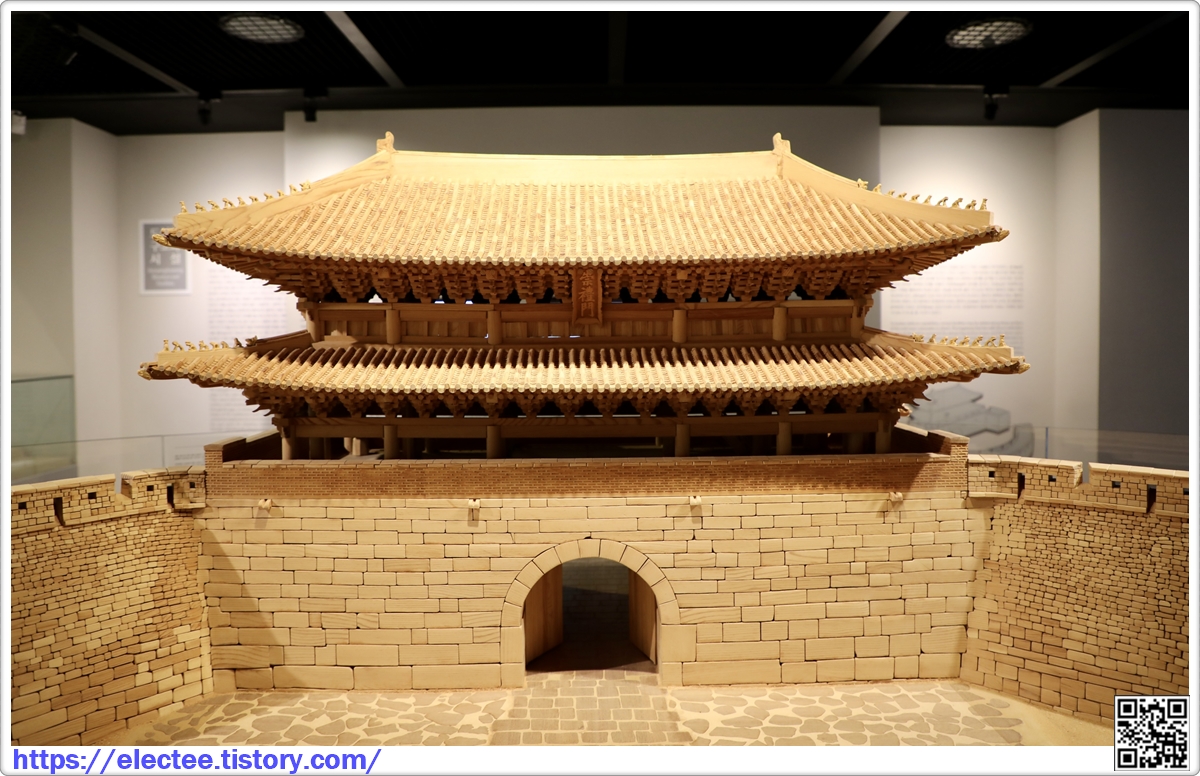
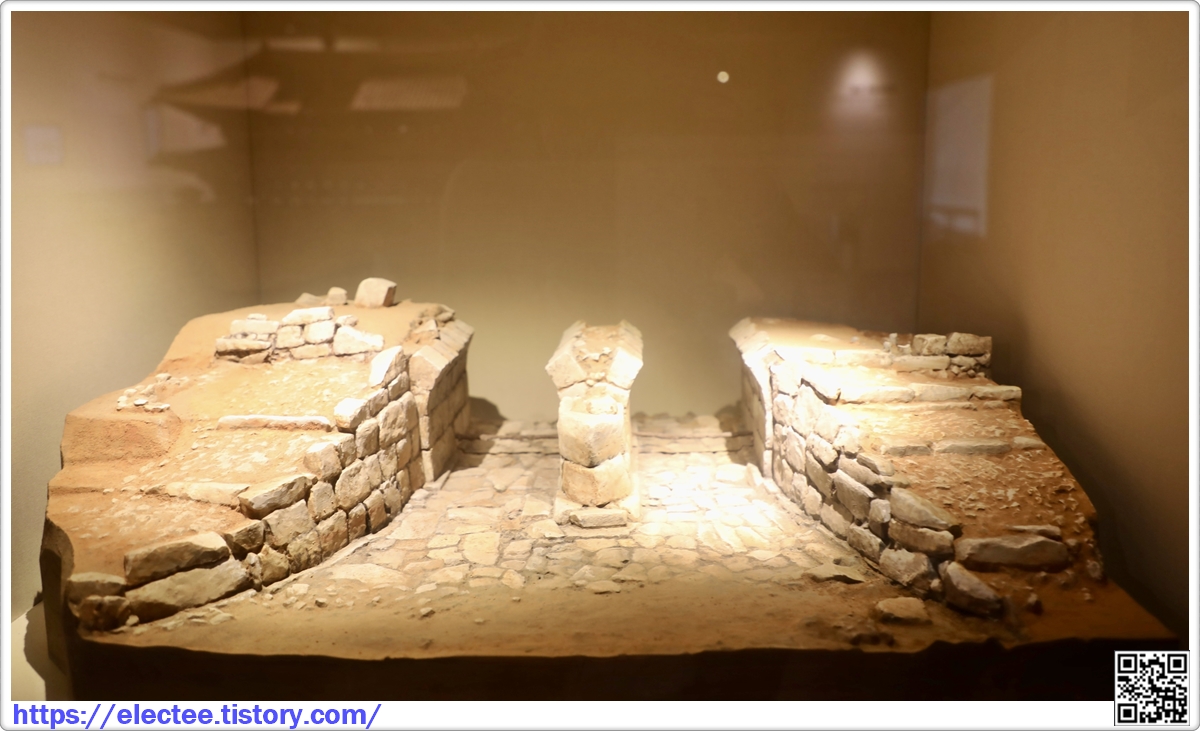
이간수문 二間水門 Igansumun (Two-arched Water Gate)
이간수문은 남산 기슭에서 청계천 본류로 흐르던 남소문동천 위에 세워졌던 두 칸에 구조의 수문이다.
1925년 경성운동장 건립으로 성곽과 함께 묻혔다가 2008년 동대문운동장 발굴 과정에서 그 실체가 확인되었다.
상부 홍예석을 제외한 나머지 부분이 완벽하게 남아 있었으며,
수문 방어를 위해 꽂았던 목재가 하부에서 확인되었다.
흐르는 물을 유도하기 위한 날개 형태의 석축이 수문 내 • 외측에 존재한다.
방어 시설 Defense Facilities
성벽에는 취약지점을 보완하거나 방어의 효율을 높이기 위한 시설들이 부가되었다.
옹성瓮城은 성문에 접근한 상대를 에워싸 공격하기 위한 시설로서, 1397년(태조 6) 흥인지문 밖에 조성되었다.
치성雉城은 성벽 일부를 밖으로 돌출시켜 3면에서 상대를 공격할 수 있게 만든 것으로 영조대 광희문 북쪽에
6개를 만들어 어영청에 관리를 맡겼다.
곡성曲城은 바깥쪽으로 굽은 지형을 활용하여 치성과 같은 기능을 하도록 쌓은 구간으로 백악산 동측과 인왕산
서측 정상부에 있다.
성랑城廊은 도성 수비 군사의 숙소이자 초소로서, 영조대 성벽에서 5보 떨어진 위치에 세웠다.
돈의문에서 숙정문에 이르는 훈련도감 담당구간에 24개, 돈의문에서 광희문에 이르는 금위영 담당구간에 24개,
숙정문에서 광희문에 이르는 어영청 담당 구간에 27개 등 총 75개가 있었다.
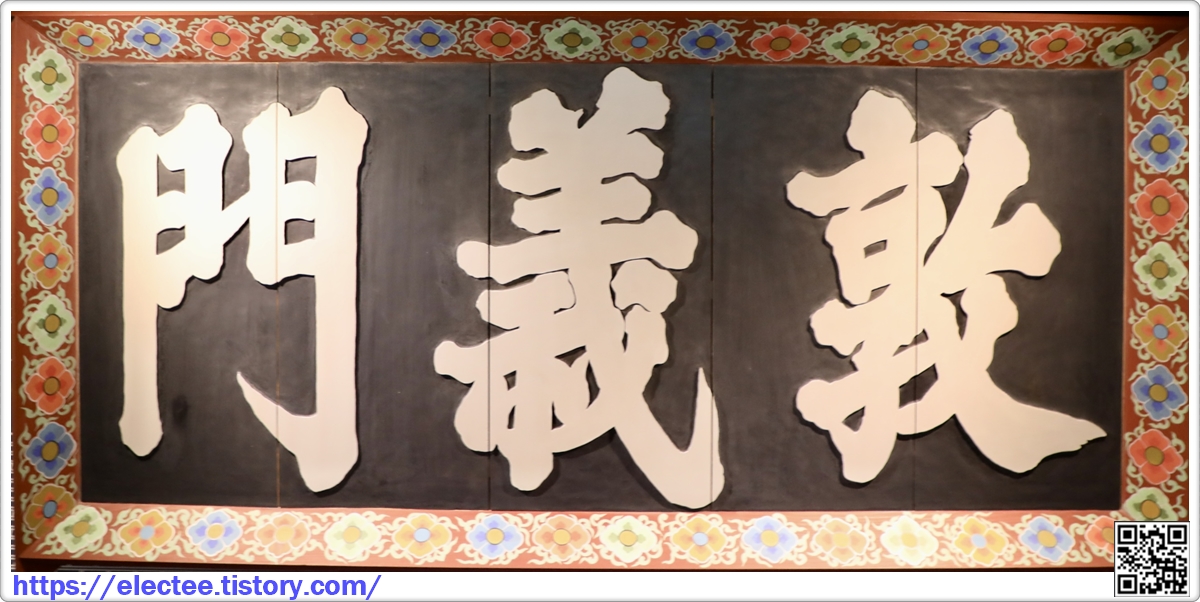
도성의 관리와 생활 Capital Wall Maintenance
도성은 왕의 존업과 나라의 권위를 표상하고 수호하는 시설로서 그에 걸맞은 권위를 지녀야 했다. 세종대 도성을 대대적으로 수축하면서 성벽을 따라 안팎으로 순심고巡審路를 내었는데.
군사들이 매일 이 길을 다니며 이상 유무를 관찰하고 이상이 발견되면 담당 관서에 알려 보수하게 했다. 왕과 외국 사신들이 자주 드나드는 숭례문과 흥인지문은 특히 화려하고 웅장하게 만들었으며, 문루는 화재 감시용 망루 역할도 했다. 도성은 서울 주민들의 일상생활을 직접 강력히 규제했을 뿐 아니라, 전국의 모든 백성에게도 상징적, 실체적인 영향을 미쳤다. 서울 주민들은 도성 문이 여닫히는 시각에 따라 일상생활을 영위했으며, 매일 성벽을 보고 살았다. 영조대 「수성절목 4ag g 이 제정된 이후에는 모든 도성민에게 유사시 달려가 지켜야 할 성벽 구간이 할당되었다. 지방에서 상경 노하는 사람들은 성벽과 성문을 보고 서울을 인지했다.
도성의 안과 밖 Inside and Outside the Capital Wall
「세종실록지리지」에 따르면 도성 안의 호수는 1만 7천15호, 성벽 바깥 10리 이내인 성저십리의 호수는
1천7백79호였다.
성저십리의 면적이 도성 안보다 5배 이상 넓었으나 인구는 1/10에 불과했다.
성저십리의 행정도 한성부가 담당했지만, 성벽은 그 안과 밖을 전혀 다른 세상으로 나누었다.
도성 안은 왕실과 국가의 존립을 위해 꼭 필요한 사람들이 거주하는 공간이었기 때문에, 도성 주민은 조세,
공물, 요역을 모두 면제받았다.
대신 도성 안을 청결하게 유지하고 국가의 지휘에 따라 일상생활을 조직할 의무를 졌다.
성문이 닫히면 도성 안에서는 남자들의 통행이 금지되었고, 문루에서 화재를 알리는 종이 울리면 모두
불을 끄러 나와야 했다.
성 밖에 사는 사람들은 과거시험을 치르거나 군인 • 공장工匠으로 불려 올 때, 혹은 도성 안 사람들의
생활용품을 공급할 때에나 도성에 들어올 수 있었다.
도성이 경계선의 기능을 잃어버린 뒤에도 오랫동안 '성 안에 산다'는 말에는 자부심이 담겨있었다.
한성부의 도성 관리 Capital Wall Management by the Hanseong Prefecture
조선왕조는 도성을 쌓은 후 그 안을 한성부限城府라 이름 지었다.
한성부는 새 수도의 행정 구역 명칭인 동시에 도성 안과 성저십리의 행정을 관할하는 정이품
관청의 이름이기도 하였다.
한성부는 호구대장 작성, 시전 관리, 범죄 단속, 산과 하천의 관리, 도로 정비 등 일반적인 행정업무 외에
형사재판 업무까지 담당하여 사헌부, 형조와 함께 삼법사三法司로 불렸다.
조선 전기에는 하부 행정단위인 오부 외 성저십리에서 행정사무를 분담하였으나,
조선 후기에는 한성부 내에 이호예병형공吏戶禮兵刑工의 육방을 두어 분담시켰다.
한양도성과 관련해서는 성벽 주변을 순찰하고 내사산의 임야를 관리했으며,
징을 쳐서 성문 개폐 시각을 알리는 좌경 업무를 담당했다.
한성부 주민들에게 도성 보수를 위한 방역坊役을 부과하는 것도 한성부가 맡은 일이었다.
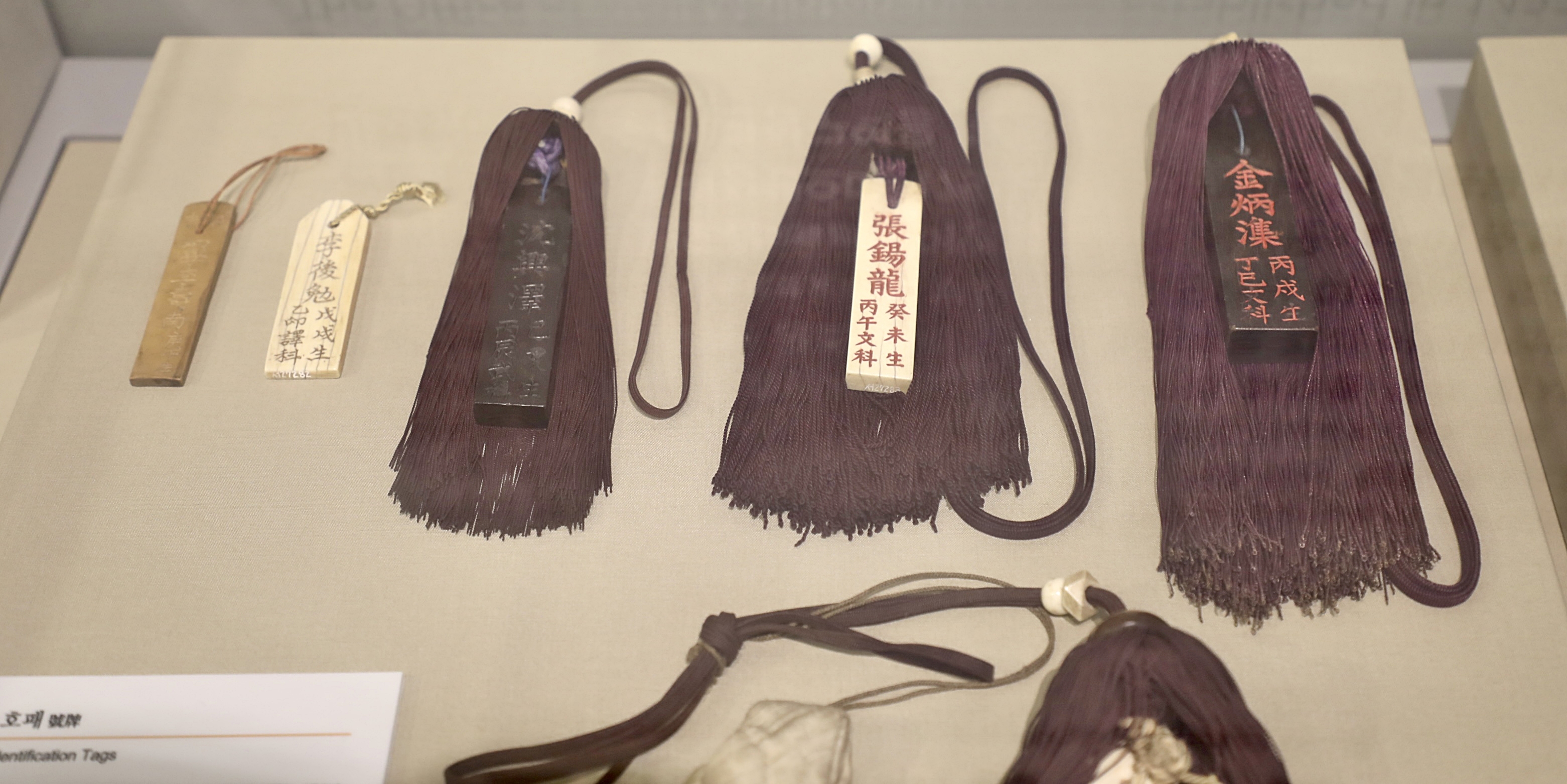
도성을 관리한 기구들 Organizations Managing the Capital Wall
한양도성 수축 공사가 끝난 1422년(세종 4), 성문도감이 설치되었다.
성문도감은 성벽의 이상 유무를 살펴 보고하고 무너진 부분을 개축하는 일을 맡았다.
1426년(세종 8)에는 성문도감을 금화도과 합쳐 수성금화도감으로 바꾸었는데, 도감 소속 병사들은
숭례문과 흥인지문 문루에서 성벽과 화재를 두루 감시하였다.
1460년(세조 6) 폐지되어 성곽 수리는 공조, 화재 감시는 한성부로 각각 이관하였다가 1481년(성종 12)
상설 기구인 수성금화사로 부활했다.
임진왜란 이후에는 도성 방어를 목적으로 설치된 금위영, 훈련도감, 어영청, 삼군이| 순찰, 경비, 수리, 개축
등 도성에 관한 업무 전반을 관장했으며, 1751년(영조 27)에는 「수성윤음」과 「수성절목」을 반포하여
군문의 관할구역을 확정했다.
도성 순라 Patrolling the Capital Wall
도둑과 화재를 방지하고, 성문의 개폐 상태와 수문군의 수직 여부를 살피며,
시설물의 이상 유무를 확인하기 위해 궁궐과 도성 둘레를 순찰하는 것을 순라巡邏라 했다.
세종대에 도성을 수축하면서 성벽 안팎에 순찰을 위한 길도 함께 만들었다.
조선 초기에는 순청巡廳이라는 기구를 설치하고 오위誤衛에서 군사를 보내 순찰하게 했다.
임진왜란 이후 삼군문이 도성 수비를 전담하게 되면서 순찰도 삼군문과 포도청이 나누어 맡았다.
좌우 양 포도청은 매일 밤 도성 내외를 순찰했고, 삼군문은 날짜를 나누어 돌아가며 순찰했다.
순찰 부대를 패牌라 했는데, 각 패는 패장 용 1명에 군사 6~12명으로 구성되었다.
순라군은 모두 군호軍號를 받았으며, 순찰하는 패가 서로 만났을 때 군호를 물어 통하지 않으면
통행금지 위반자로 취급되어 처벌받았다.

성곽 수리 Repairing the Capital Wall
조선 전기에는 성곽에 무너진 구간이 생길 경우 지방 군사를 동원하여 수리했다.
그러나 숙종대 도성을 대대적으로 재정비한 이후로는 성문과 성곽 수리도 삼군문에서 책임졌다.
각 군문은 순찰 도중 성벽이 무너진 구간을 발견하면, 정해진 절차에 따라 왕에게 보고했다.
보고를 받은 왕은 먼저 선공감繕工監에 명하여 무너진 성벽 주변에 울타리를 치게 하고 관할 군문에
파수把守와 수리 공사를 지시했다.
관할 군문에서는 병사를 현장에 보내 공사가 끝날 때까지 돌아가며 수직 하게 하는 한편,
공장들을 모집하여 일을 맡겼다. 공장들에게는 맡은 구간의 길이에 따라 보수를 지급했다.
체성 공사가 마무리되면 군병들을 철수시키고 여장을 쌓았다.
첫 보고일로부터 여장 공사가 끝날 때까지는 대략 2개월의 시일이 걸렸다.

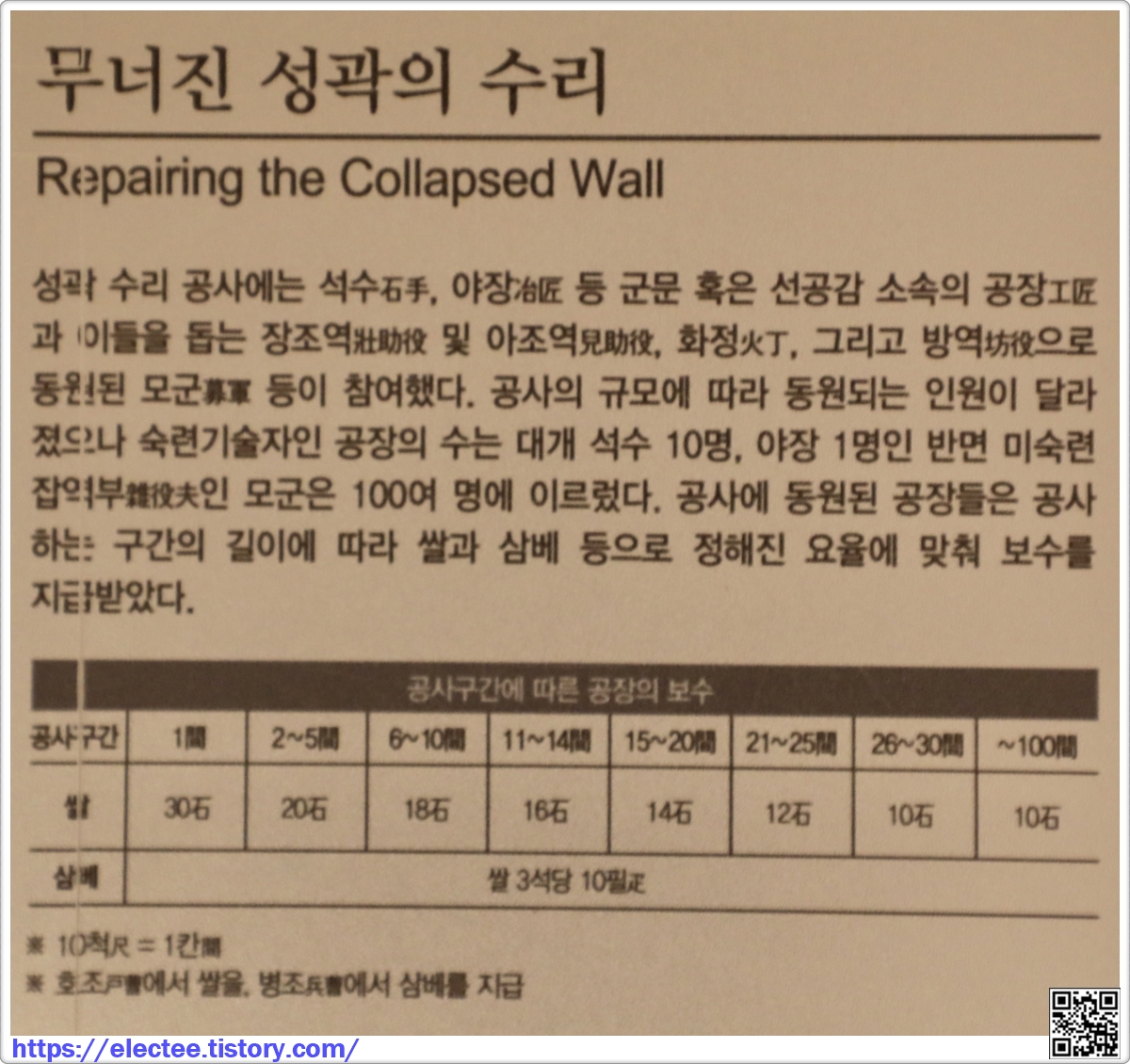
성문 출입 Gate Entry and Exit
왕이 성 밖으로 나가는 경우는 능행陵幸이 대부분이었는데, 능의 위치에 따라 숭례문과 흥인지문,
돈의문을 주로 사용하였다.
중국 사신을 맞이할 때에는 돈의문과 숭례문을 이용했고 북교北郊에서 기우제를 지내거나 동교東郊에서
군사훈련을 참관할 때에는 창의문과 혜화문으로 드나들었다.
중국 사신들은 숭례문과 돈의문, 여진족 사신들은 혜화문을 이용했다.
국장國葬 때 대여大輿는 숭례문, 흥인지문, 돈의문을 통과했다.
일반 신하와 백성들의 상여는 소의문과 광희문으로만 나갈 수 있었다.
도성 안에서 소비되는 물자는 대부분 성 밖에서 조달되어야 했기 때문에 성문으로는 우마차로도 빈번히
드나들었다.
도성 상업이 발달한 19세기에는 매일 새벽 숭례문과 흥인지문 밖에서 문이 열리기를 기다리는 우마차 행렬이
수백 대씩이었다.
한양의 동쪽 지역 East Area of Hanyang
한양의 동쪽 지역은 행정적으로 한성부의 동부와 남부가 속한 곳이다.
흥인지문을 기준으로 북쪽의 혜화문에서 남쪽의 광희문까지, 한양 도성 동쪽 성곽의 안팎 지역을 아우른다.
종묘宗廟와 경모궁景慕宮 등 제향 공간을 비롯해 조선 최고의 교육 기관인 성균관이 위치하였다.
도성 안에서 고도가 가장 낮은 지역으로, 외적의 출입이 용이한 지형적 약점을 보완하고 방비를 강화하기 위해
다수의 방어 시설과 군영 등이 배치되었다.
Administratively, the area on the east side of Hanyang, the old name of Seoul, belonged to either
the East District or South District of the Capital Prefecture, Hanseongbu.
It included the area in and around Heunginjimun (Gate), from Hyehwamun (Gate) in the north
to Gwanghuimun (Gate) in the south.
Being the lowest area in the entire city, various wall defenses and military encampments were located
here to strengthen the city defense and overcome topographical weakness.
한양도성의 성문 Operation of the Capital Wall Gates
조선시대 한양도성의 여덟 성문은 성 안팎의 사람과 물자가 출입하는 유일한 통로이자 한양과 지방을 잇는
주요 도로와 연결되는 중요한 지점이었습니다.
성 밖으로 행차하는 왕의 행렬뿐만 아니라 상경한 지방민과 외국 사신 등 다양한 사람들이 드나들었고,
전국의 인력과 물자는 성문을 통해 한양으로 모여들었다가 흩어졌습니다.
날이 저물어 성문이 닫히면 다음날 다시 열릴 때까지 도성 안에서의 모든 통행이 금지되었기 때문에,
도성민의 하루는 성문의 개폐 시간에 맞춰 시작되었다가 마무리되었습니다.
이 전시는 조선시대 다양한 기록 자료에 등장하는 성문 관리에 대해 소개합니다.
성문 개폐가 도성 방어 및 주민 생활과 밀접하게 닿아 있었던 만큼 성문은 철저한 규칙에 따라 관리·운영되었습니다.
각 문에서 있었던 다양한 사건들을 통해 한양도성의 성문 관리 체계를 확인하는 자리가 되길 바랍니다.
The Joseon capital, Hanyang, was a walled city with eight gates, which were the sole points through
which people and goods could enter or leave the city.
These portals were also important as the starting points of major roads that led from the capital
to the provincial areas throughout the country.
'The capital wall gates were closed at sundown and a curfew took effect inside the city until they were
reopened the following morning.
Thus, the lives of the capital residents were regulated according to the status of the gates.
This exhibition introduces anecdotes about the opening and closing of the capital gates as found in
numerous documents from the Joseon period.
The gates were supervised and operated according to detailed rules, as the access to them closely
touched the lives of the residents.
This exhibition aims to confirm the system capital gate management by citing various incidents that
occurred at each one.
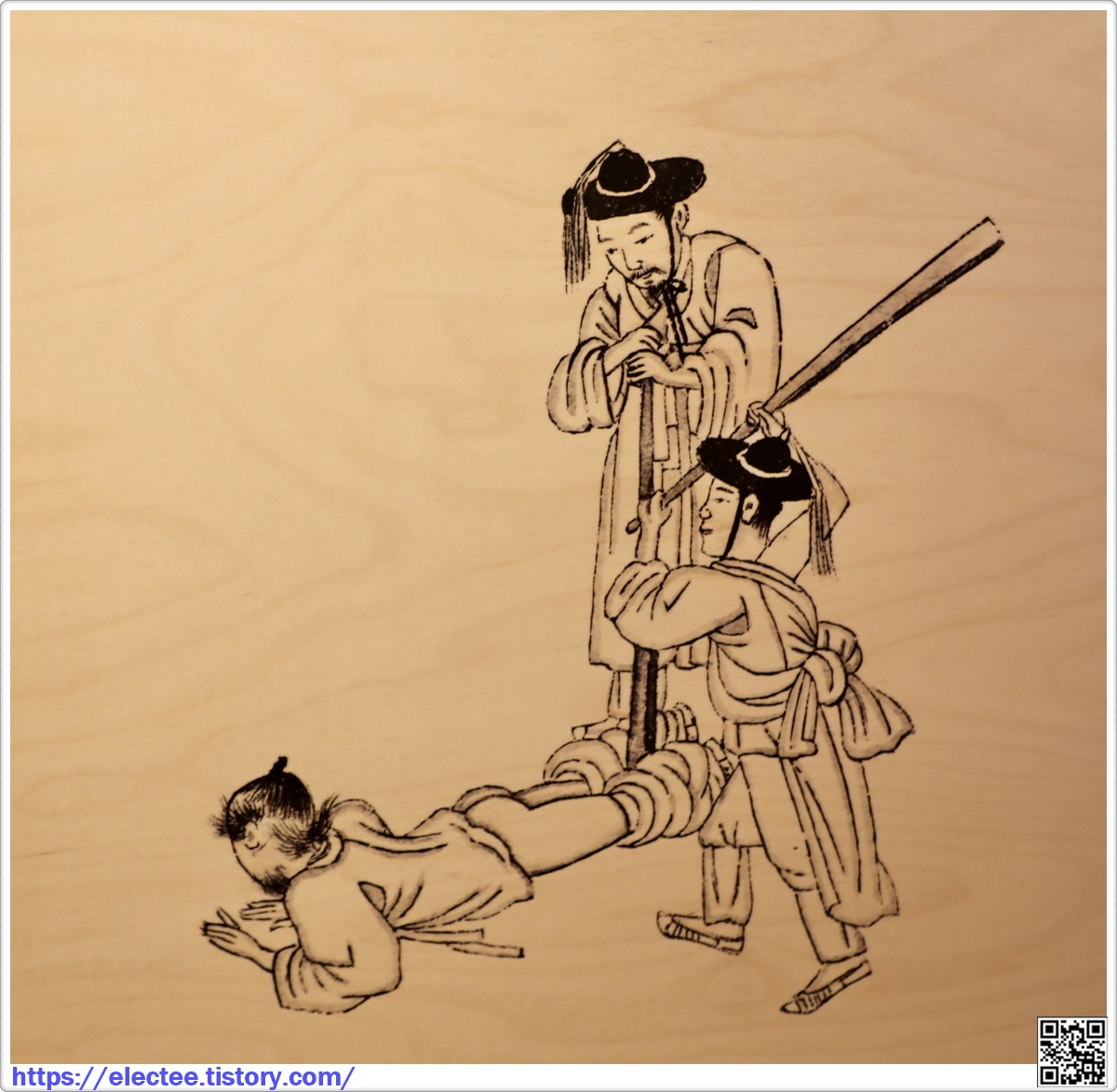
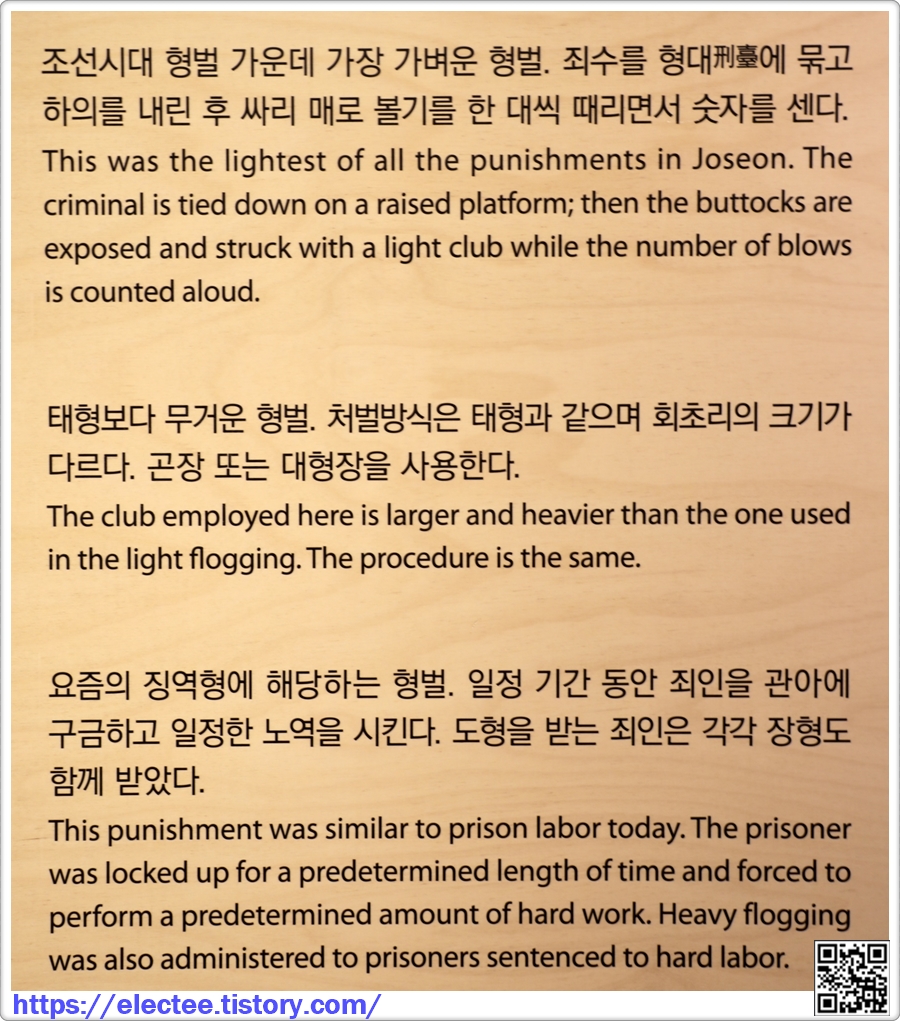
성문 관리와 형량 Capital Gate Supervision and Punishments for Violations
조선시대 한양도성의 성문은 도성을 출입하는 유일한 통로였기에 성문의 관리는 도성의 방어에 중요한 일이었다.
따라서 성문의 관리를 소홀히 한 수문군이나 성문 관리의 업무를 방해한 자는 「대명률大明律」에 의거 처벌받았다.
「대명률」은 중국 명나라의 형률서로 조선 건국 직후부터 현행 형법전刑法典으로 활용되었다.
이에 따라, 성문을 제대로 잠그지 않은 자는 장杖 80대, 때가 아닌데 마음대로 열고 닫은 자는 장 100대,
부험을 받은 호군護軍으로서 야간 당직에 빠진 자는 장 60대와 도徒 1년에 처해졌다.
성 문의 자물쇠를 훔친 자가 있으면 수범首犯과 종범從犯을 구분하지 않고 모두 태 100대를 친 후 종신 징역형을 내렸다.
The capital gates in Joseon were the only means of access to the city, so supervising the gates as
an important duty related to capital defense.
Therefore, gate guards who were negligent in their duties or persons who interfered with capital gate
supervision were punished according to stipulations in the Great Ming Code.
For example, a gatekeeper who failed to lock the gate would receive 80 strokes with a light club,
and one who opened the gate without authorization during curfew would receive 100 strokes with a
light club.
A third deputy commander who failed to be on duty to receive a tally would be beaten with 60 strokes
and sentenced to one year at hard labor.
성문 수직 Capital Gate Watch
조선 초기 「경국대전」에서 규정한 수문군의 숫자는 8명으로 숭례문, 흥인문, 돈의문, 혜화문에는 오위五衛 소속의
호군護軍을, 나머지 문들은 사직司直 이하 무관인 오원誤員을 보내 보병을 거느리고 파수把守하게 하였다.
임진왜란 이후 삼군문에서 도성의 관리를 맡게 됨에 따라 훈련도감에서 돈의문, 창의문에 각 6명과 숙정문에
2명을, 금위영에서 숭례문, 소의문에 각 6명을, 그리고 어영청에서 흥인문, 광희문, 혜화문에 각 6명의 수문군을
보내 성문을 지켰다.
각 문의 수문군은 성문을 제시간에 열고 닫지 못하거나 관리 소홀로 성문의 일부가 훼손되었을 경우, 혹은 함부로
수직 하는 자리를 비웠을 경우 그 죄를 따져 엄하게 처벌받았다.
The National Code, promulgated in early Joseon, stipulated that eight guards be assigned to each gate in
the capital wall.
Those watching Sungnyemun, Heunginmun, Donuimun and Hyehwamun had to be of the third deputy
commander rank and assigned to one of the Five Military Commands in the capital.
A military officer of fifth rank or lower would be sent to each of the other gates to oversee
the gatekeeping crew.
After the Imjin War with Japan in the 1590s, the Three Army Commands took over the capital
gatekeeping duties, the Military Training Command would send six-person crews to guard
Donuimun and Changuimun as well as two-person teams to Sukjeongmun.
The Royal Division would send six-person crews to Sungnyemun and Souimun,
while the Forbidden Guard Division as responsible for sending six-person crews to Heunginmun,
Gwanghuimun, and Hyehwamun.
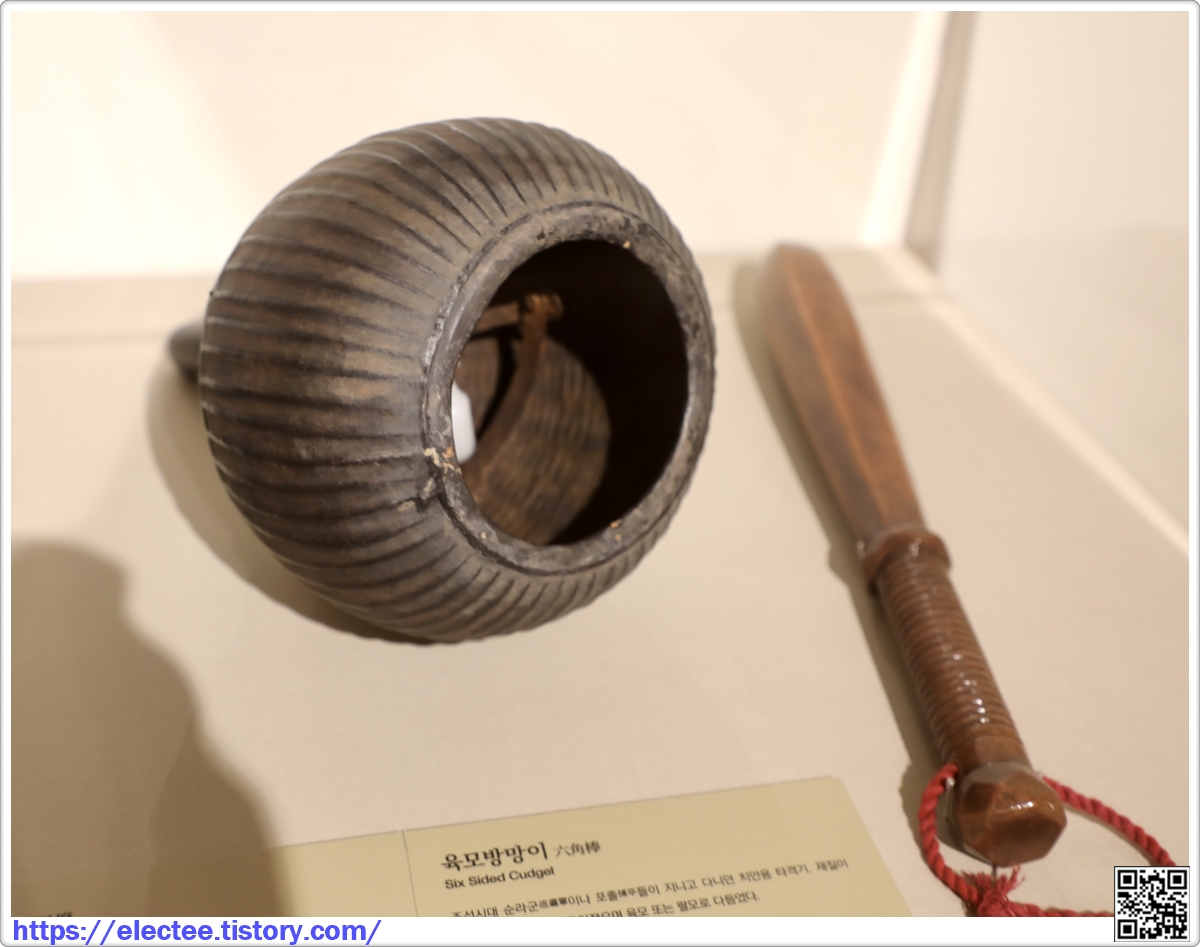

부험, 닫힌 문을 열다 Tally for Opening the Gate during Curfew
인정 이후에 성문을 열려면 각 문의 부험符驗을 제시해야 했다.
부험은 둥근 모양의 목제 패로 세종 25년(1443) 6월 병조의 건의로 당의 제도를 모방하여 처음으로 제작,
사용하기 시작하였다.
초기에는 양면에 전서篆書로 신부信符라 쓰고, 도장을 찍었으나 후기에는 한 면에 부험이라 쓰고 다른 면에 해당
문의 이름과 시간을 새겼다.
흥인문, 숭례문, 돈의문, 혜화문에는 모두 매 경更마다 사용하는 부험이 있었다.
각 문의 부험은 반으로 나누어서 왼쪽 부분開門左符은 궁중에 비치하고 오른쪽 부분 開門右符 은 각 문의 수직소
守直所에 두었다가 유사시 개문좌부를 내려 수문장이 가진 우부와 서로 맞추어보고 문을 열 수 있게 했다.
창의문, 소의문, 광희문, 숙정문에는 부험 없이 별도의 개문표신이 사용되었다.
In an emergency, a special authority tally could be submitted to the gatekeeper to have the gate opened
during curfew.
This round wooden tablet had the word buheom (符驗) written on one side, while on the reverse side was
etched the corresponding gate name and time (i.e. double-hour period).
Heunginmun, Sungnyemun, Donuimun, and Hyehwamun all used the tallies with designated times on them.
The tallies for each gate were split into left and right halves; the left side was kept inside the palace,
while the right side was left at the gatekeeper's post.
These two sides had to match for the gate to be opened.
A written pass was used in place of the tally to gain access to Changuimun, Souimun, Gwanghuimun or
Sukjeongmun during curfew.
문 개폐 Gate Opening and Closing
성문을 열고 닫는 일은 각 문을 지키는 수문군守門軍이 맡았다.
인정을 알리는 종이 울리면 성문을 닫고 빗장을 가로지른 후, 문의 위와 아래를 각각 자물쇠로 잠갔다.
성문의 열쇠는 병조兵曹에서 보관하되, 해당 문의 군사는 전날 교대 시에 반납했던 열쇠를 다음날 새벽에
받아와서 파루가 될 때까지 기다렸다가 문을 열었다.
조선 초에는 4경 말四更末에 열쇠를 받아가는 것이 규례였으나, 조선 후기에 접어들면서 4경 1점 四更一點에
받아 가는 것으로 바뀌었다.
성문이 닫혀 있는 동안 도성 내외의 출입과 통행이 금지되었으며, 이를 어길 경우 처벌받았다.
통행금지를 위반한 자는 경수소警守所에 구금하였다가 다음날 위반한 시간에 따라 10도 표에서 30도까지
차등 있게 곤장을 때렸다.
Gatekeeping soldiers were in charge of opening and closing the gates,
and keys to the gate locks were kept in the offices of the Ministry of War.
The on-duty soldier who closed each gate would turn in the key then coming off duty,
and the next soldier coming on duty would pick it up and wait for the curfew time to end.
In principle, no one was to pass through the city and the gate during curfew.
If someone violated the curfew, he would face punishment
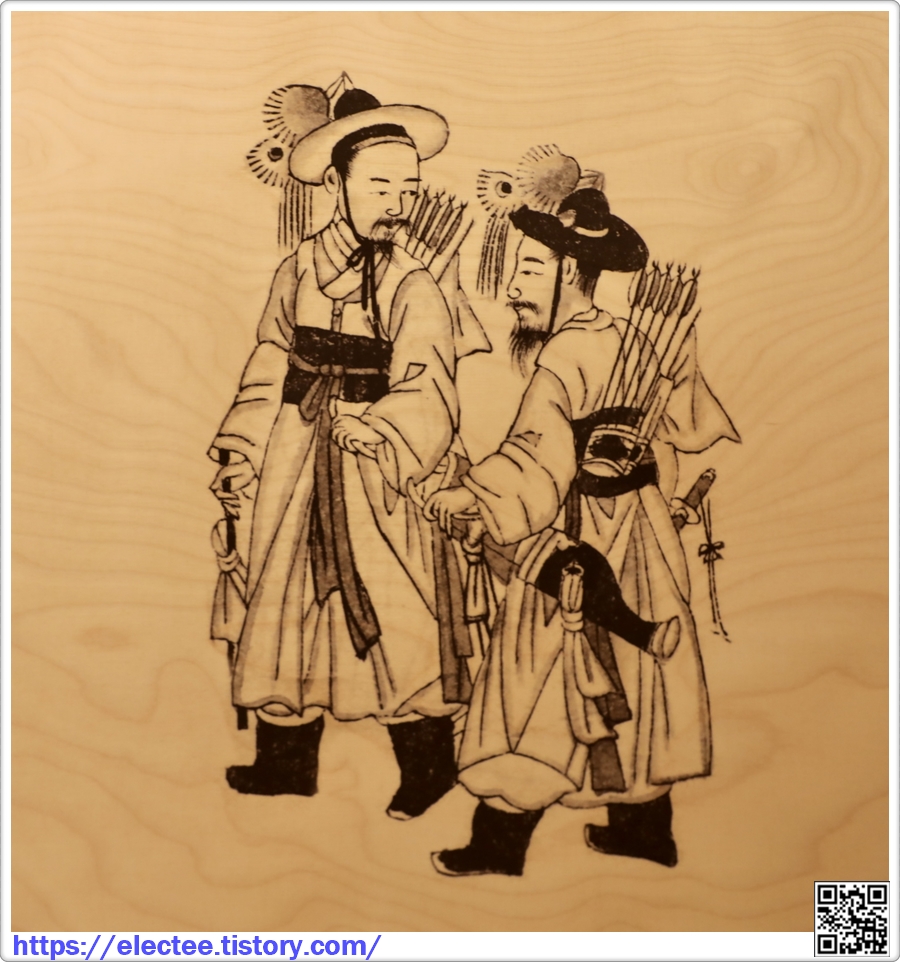
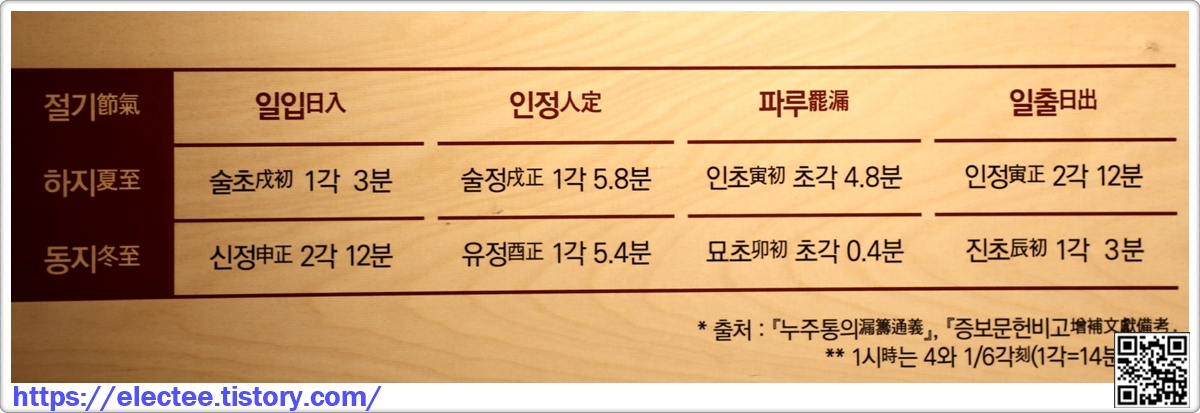
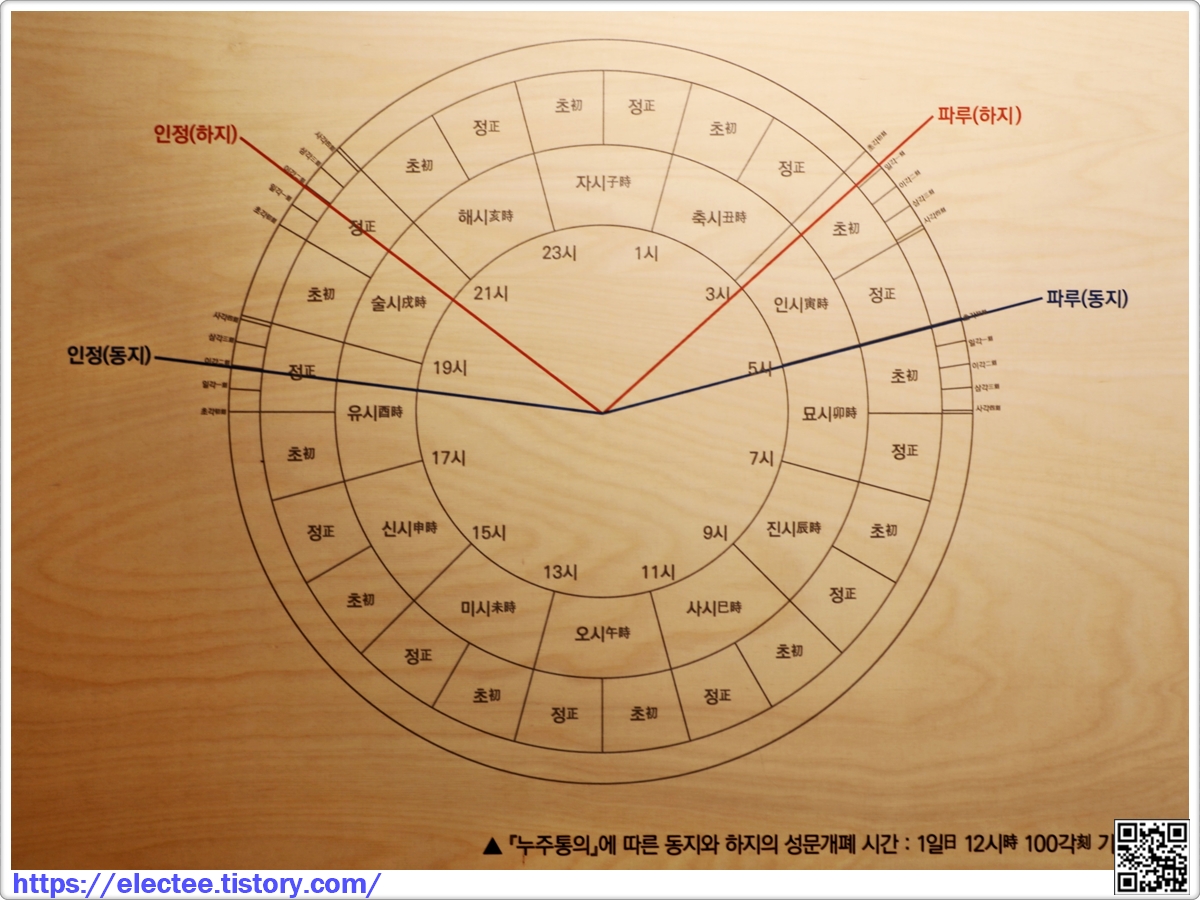
도성문의 개폐 Opening and Closing the City Wall Gates
인정과 파루 Injeong and Paru
한양도성의 성문은 인정 시에 닫고 파루에 여는 것이 원칙이었다.
초경 3점初更三點에 종루의 종이 28번 울리면 인정, 5경 3점五更三點에 종이 33번 울리면 파루였는데,
해가 지는 시각을 기준으로 정했기 때문에 계절에 따라 성문을 여닫는 시각이 달랐다.
즉, 밤 시간을 초경부터 5경까지 다섯으로 나누고 이를 다시 다섯 점으로 세분하는 조선시대 시간
계산법에 따라 여름에는 문을 늦게 닫고 일찍 열었다가 겨울에는 문을 일찍 닫고 늦게 열었다.
조선시대 천문서인 「누주통의漏籌通義」에 따르면, 동지冬至에 인정이 유정酉正 1각刻 5.4분分,
파루가 묘초卯初 초각初刻 0.4분이었던 반면, 하지夏至에는 인정이 술정戌正 1각 5.8분,
파루가 인초寅初 초각 4.8분이었다.
The evening closure of the capital gates was called injeong, while the dawn reopening was known as paru.
The nighttime was divided into 5 watches of approximately two hours each, and these were further divided
into five points.
The bell inside the pavilion would ring 28 times at the third point of the first watch, signaling the gate closure
and curfew alert.
The curfew was lifted, and the gates opened, at the third point of the fifth watch, when the bell was rung 33 times.
The nighttime watches began at sundown, so the gates would be closed later and opened earlier during the
summer than in the winter.
2011년
'서울성곽'을 '서울 한양도성'으로 문화재 명칭 변경
'Seoul City Wall' renamed 'Hanyangdoseong the Seoul City Wall'

백악 구간 Baegak Section
창의문에서 혜화문까지 Changuimun to Hyehwamun
창의문에서 백악산을 넘어 혜화문에 이르는 구간이다.
백악산신을 모시는 사당이 있는 산이라 하여 백악산이라 불렸다.
북악산北岳山, 면악산面岳山, 공극산拱極山 이라고도 한다.
서울의 주산으로 내사산 중 가장 높으며(342.5m), 산세가 '반쯤 핀 모란꽃'에 비유될 만큼 아름답다.
한양도성은 백악산을 기점으로 축조되었다.
1968년 1 · 21 사태 이후 40년 가까이 출입이 제한되다가 2007년부터 시민에게 개방되었다.
This section starts at Changuimun (Gate), crosses over Baegaksan (Mountain) and extends
to Hyehwamun (Gate).
In geomantic terms, this is the "master mountain" for the capital.
It is the tallest (342.5m) of the four inner mountains
that surround the capital, and its beautiful shape has been compared to "a peony in half bloom."
This was the starting point for the construction of the Hanyangdoseong.
The section was put off limits in the wake of a North Korean command raid on the Cheongwadae
(Presidential Mansion) in 1968 but was reopened to the public in 2007 after almost 40 years.
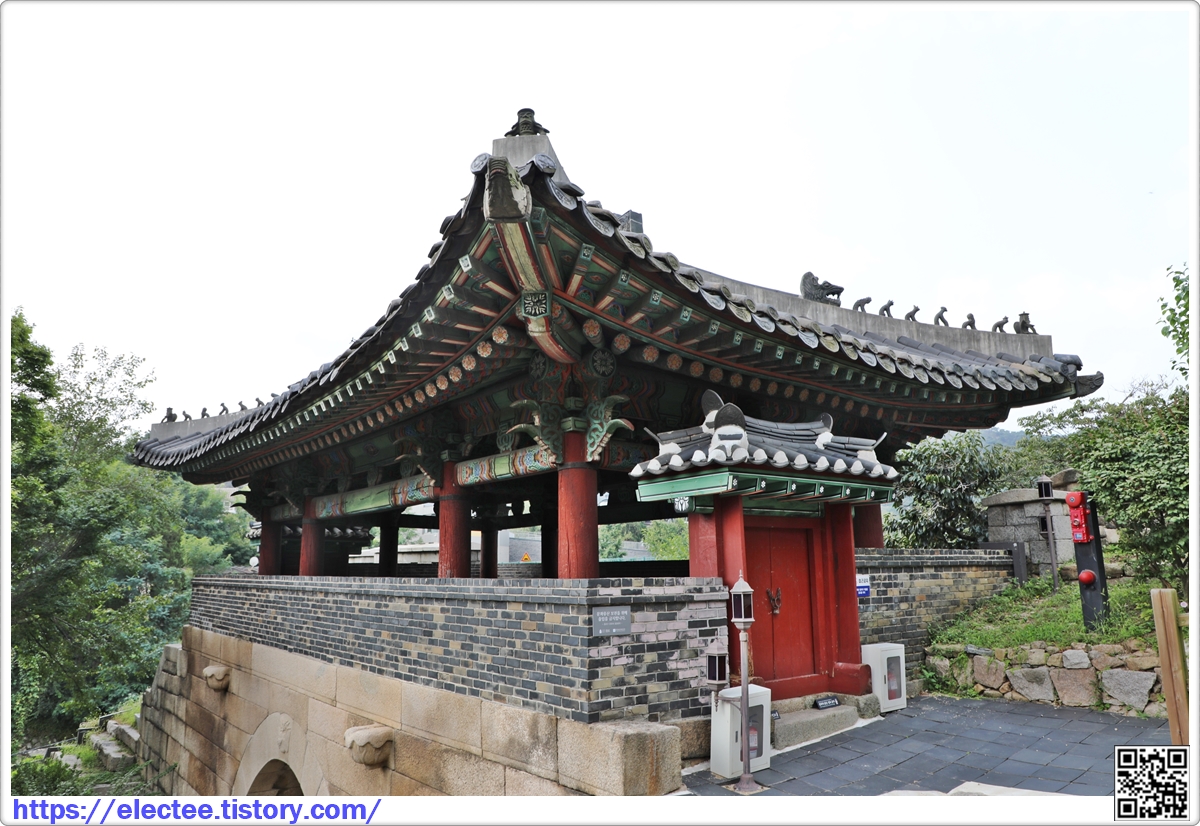
낙산 구간 Naksan Section
혜화문에서 흥인지문까지 Hyehwamun to Heunginjimun
혜화문에서 낙산을 지나 흥인지문까지 이어지는 구간이다.
산의 모양이 낙타의 등과 같아 낙산이라 하며 낙타산 혹은 타락산이라 부르기도 한다.
서울의 좌청룡초에 해당하는 산으로 내사산 중 가장 낮다(124.4m).
가톨릭대학교를 따라 이어진 성벽길을 걸으면 시기별로 달 라진 축성 모습을 비교해 볼 수 있다.
그리고 장수마을, 이화마을 등 옛 마을의 정취를 느낄 수 있는 성곽마을도 둘러볼 수 있다.
This section begins at Hyehwamun (Gate), crosses over Naksan (Mountain)
and ends at Heunginjimun (Gate).
Naksan stood on the eastern side of the capital, thus it represented the guardian
spirit of the eastern quadrant.
It is the lowest (124.4m) of the four inner mountains.
The wall-side hiking trail outside the Catholic University campus passes by various types
of wall construction
employed over the years, providing hikers with an opportunity to compare.
In addition, the Jangsu and Ihwa communities maintain the atmosphere of the old
"wall-side community" that once thrived here.

흥인지문 구간 Heunginjimun Section
흥인지문에서 장충체육관까지 Heunginjimun to Jangchung Arena
흥인지문 구간은 흥인지문에서 광희문을 지나 장충체육관에 이르는 구간이다.
한양도성의 전 구간 가운데 가장 지대가 낮다.
흥인지문과 광희문 사이에는 오간수문 터와 2009년 발굴•복원된 이간수문이 자리하고 있다.
광희문 성벽을 따라 장충동 주택가로 들어서면 한양도성의 흔적이 사라지는데,
1930년대 주택단지 조성으로 성벽이 파괴된 지역이다.
현재 성돌은 주택의 담장이나 축대로 사용되고 있다.
This Section, which starts at Heunginjimun (Gate), runs through Gwanghuimun (Gate)
and ends at Jangchung Arena, was built entirely on the flat-land east of the capital. As such it is
the lowest of all the Hanyangdoseong sections.
The site of the former Ogansumun (five-arch floodgate) and Igansumun (two-arch floodgate,
uncovered in 2009),
are located between Heung-injimun and Gwanghumun.
Follow the wall from Gwanghui-mun into the residential area of Jangchung-dong and traces
of the Hanyangdoseong disappear, because the wall was removed in the 1930s to make way
for a housing complex.

남산(목멱산) 구간 Namsan (Mongmyeoksan) Section
장충체육관에서 백범광장까지 Jangchung Arena to Baekbeom Square
남산 구간은 장충체육관 뒷길에서 남산공원까지 이어지는 구간이다.
남산(270.9m)의 또 다른 이름인 목멱산目覓山은 남산을 뜻하는 '마모'의 이두식 표현에서 유래한다.
서울의 안산案山에 해당하여 조선 초기부터 국태민안을 비는 국사당을 이 산에 두었다.
또 정상에는 변방의 변란을 알리는 봉수대를 설치하여 궁궐에서 직접 살릴 수 있게 하였다.
남산의 동쪽 능선을 따라 조성된 나무계단길 옆에는 태조 때 성벽이 초축 당시의 모습을 유지한 채
상당 부분 남아 있다.
The Namsan Section extends from the street behind Jangchung Arena to Baekbeom Square.
Namsan (Mountain) was also known as Mongmyeoksan (270.9m).
In geomantic terms, this was the "table mountain" for the capital, and a state shrine was maintained
on its slopes from early to pray for peace for the state and security for the people.
In addition, beacon platforms were built on top as part of early warning system for border incursions
or uprisings around the country.
A stretch of the wall along wooden stairway that follows ridgeline east of Namsan now appears
the way it did when it was built during king Taejo's reign (r. 1392-98).
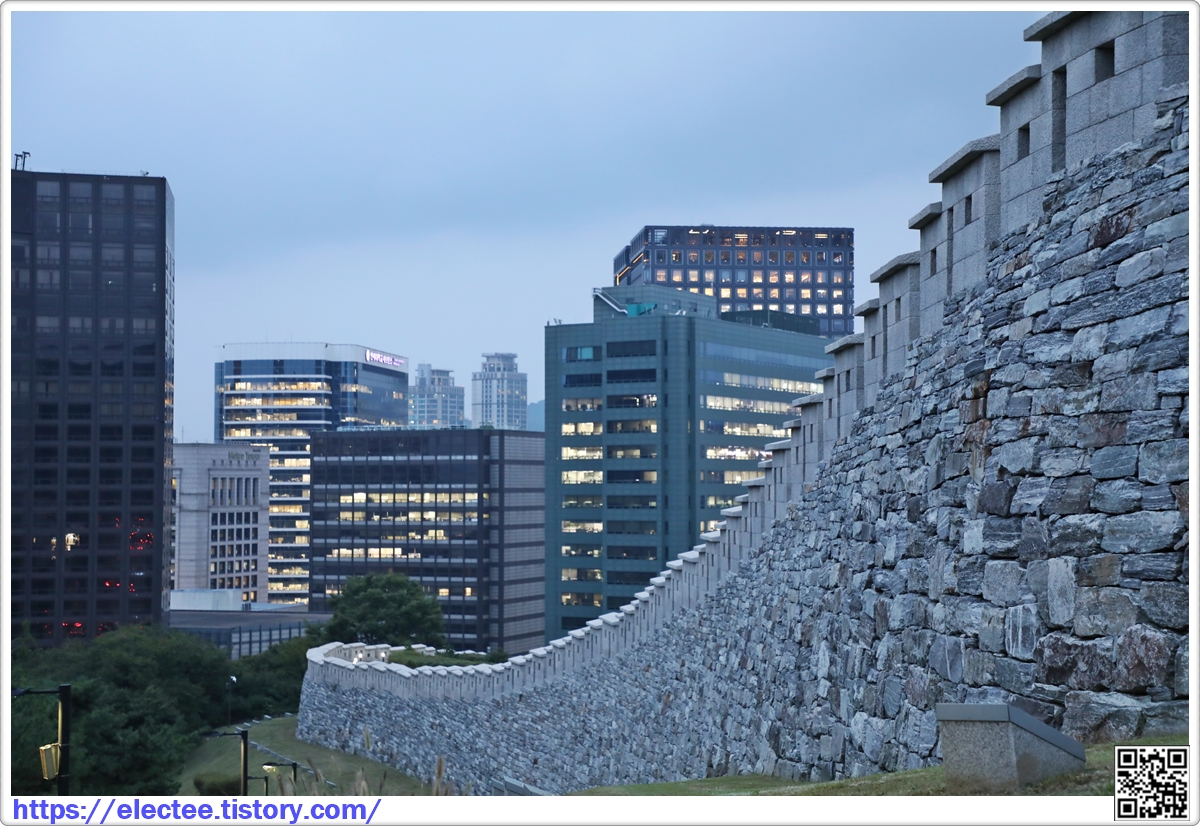
숭례문 구간 Sungnyemun Section
백범광장에서 돈의문 터까지 Baekbeom Square to Former Donuimun Site
숭례문 구간은 남산의 백범광장에서 돈의문 터까지 이어지는 구간이다.
한양도성의 평지 구간으로 성벽이 가장 많이 훼손되어 있다.
한양도성의 흔적을 발견할 수 있는 곳이 두 군데 있는데,
대한상공회의소에서 퍼시픽타워까지 이어지는 곳에 성벽의 일부가 담장처럼 남아 있고,
창덕여자 중학교 담장 아랫부분에서 50m 정도 네모반듯한 성벽의 일부를 볼 수 있다.
This section was built on flat ground, so most of it has been lost, but there are still two places
where traces of the Hanyangdo-seong can be found.
The lower part of the original wall remains as walls for properties from the Korea Chamber of Commerce
Building to the Pacific Tower, and the lower part of the 50m wall for Changdeok Girls' Middle School
consists of perfectly square stone blocks that were once part of the Hanyangdoseong.

인왕산 구간 Inwangsan Section
돈의문 터에서 윤동주 시인의 언덕까지 Former Donuimun Site to the Hill of Poet Yun Dong-ju
인왕산 구간은 돈의문 터에서 시작해 인왕산을 넘어 윤동주 시인의 언덕까지 이어지는 구간이다.
인왕산(339.9m)은 산기슭에 인왕사라는 사찰이 있어 유래된 이름으로 조선 초에는 서산西山라고도 불렸다.
서울의 우백호右白虎에 해당한다.
거대한 바위들이 노출되어 있는 바 위산으로 치마바위, 선바위, 기차바위 등 기암괴석이 많다.
1968년 1·21 사태 이후 민간인 출입이 통제되다가 1993년 개방되었다.
인왕산 정상에서 치마바위를 지나 탕춘대성 갈림길에서 성 바깥길을 걸으면,
시기별 축성 방법의 차이를 확인할 수 있는 구간이 나온다.
The Inwangsan Section begins at the former site of Donuimun (Gate), crosses over Inwangsan (Mountain)
and continues as far as the Hill of Poet Yun Dongju.
Inwangsan (339.9m), stands to the west of the city and corresponds to the guardian of the western quadrant.
The area was declared off limits after the North Korean commando attack in January 1968 but was reopened
to the public in 1993.
A stretch of the Hanyangdoseong, running from Skirt Rock at the top of Inwangsan to the fork that leads to Tangchundaeseong (Fortress), clearly contrasts the different wall-building techniques employed during
different time periods of Joseon.
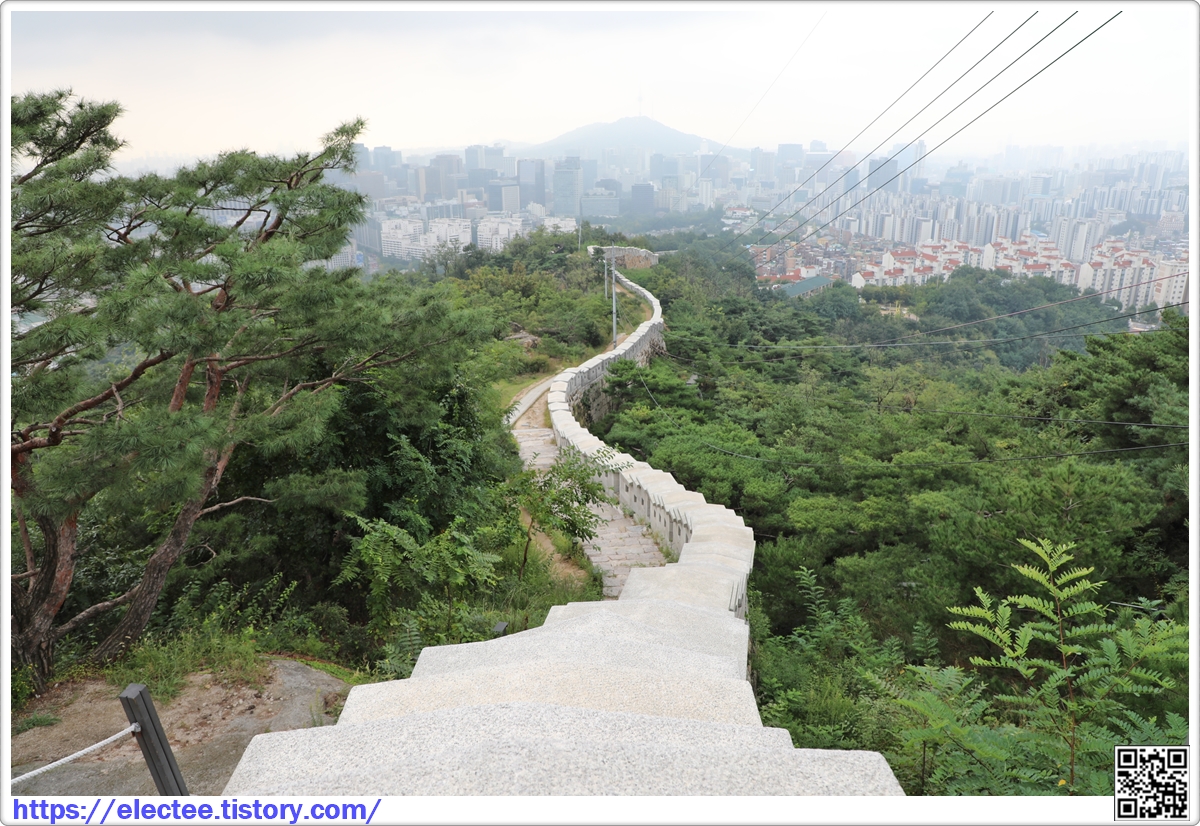
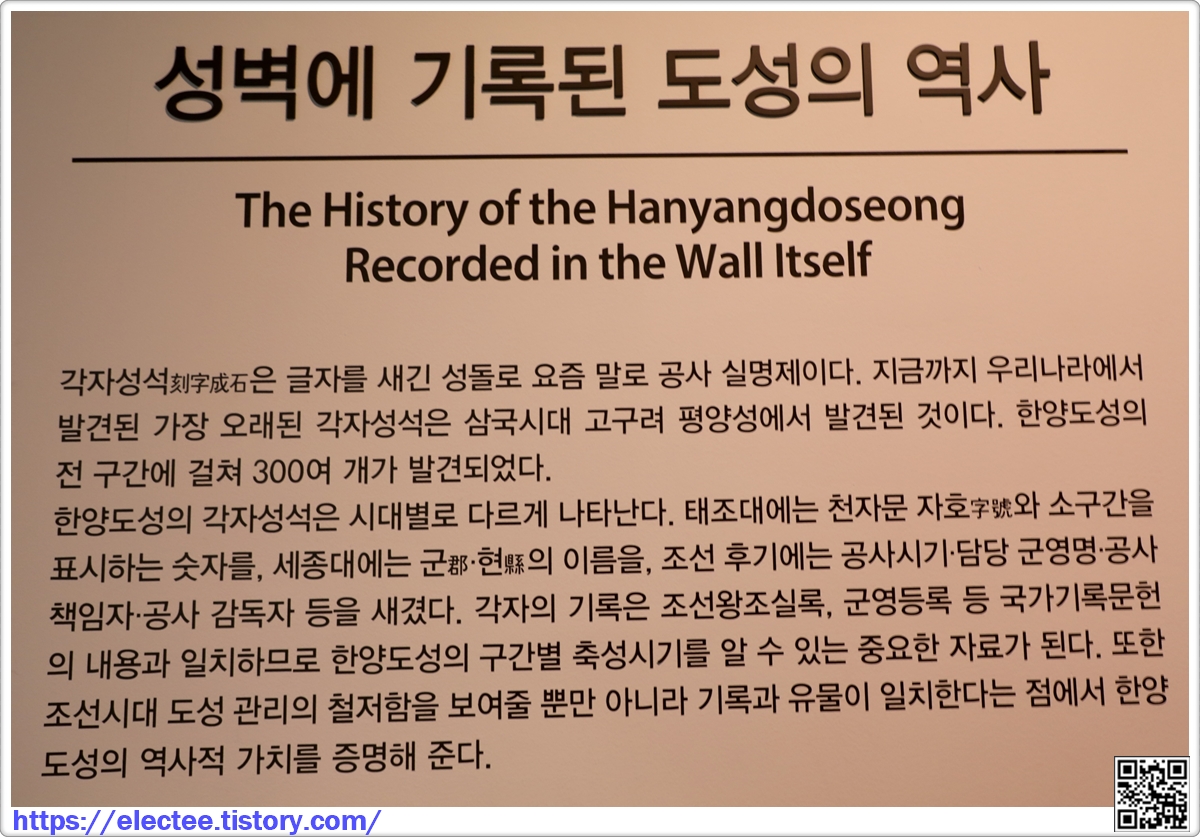
The inscribed stone blocks served as a system of accountability for work performed.
They can be found along the entire length of the Hanyangdoseong, about 300 of them have been identified to date.
The inscribed stone blocks in the Hanyangdoseong vary in their appearance and content according to the time
period in which they were carved.
The data inscribed stone blocks are consistent with those recorded in the Annals of the Joseon Dynasty,
military garrison registers, and other state documents, making the blocks an important source for
determining the precise time when construction and repair work was carried out particular wall sections.
They indicate the care taken by the Joseon government in maintaining the wall, and are testimony to the
historical value of the Hanyang-doseong.

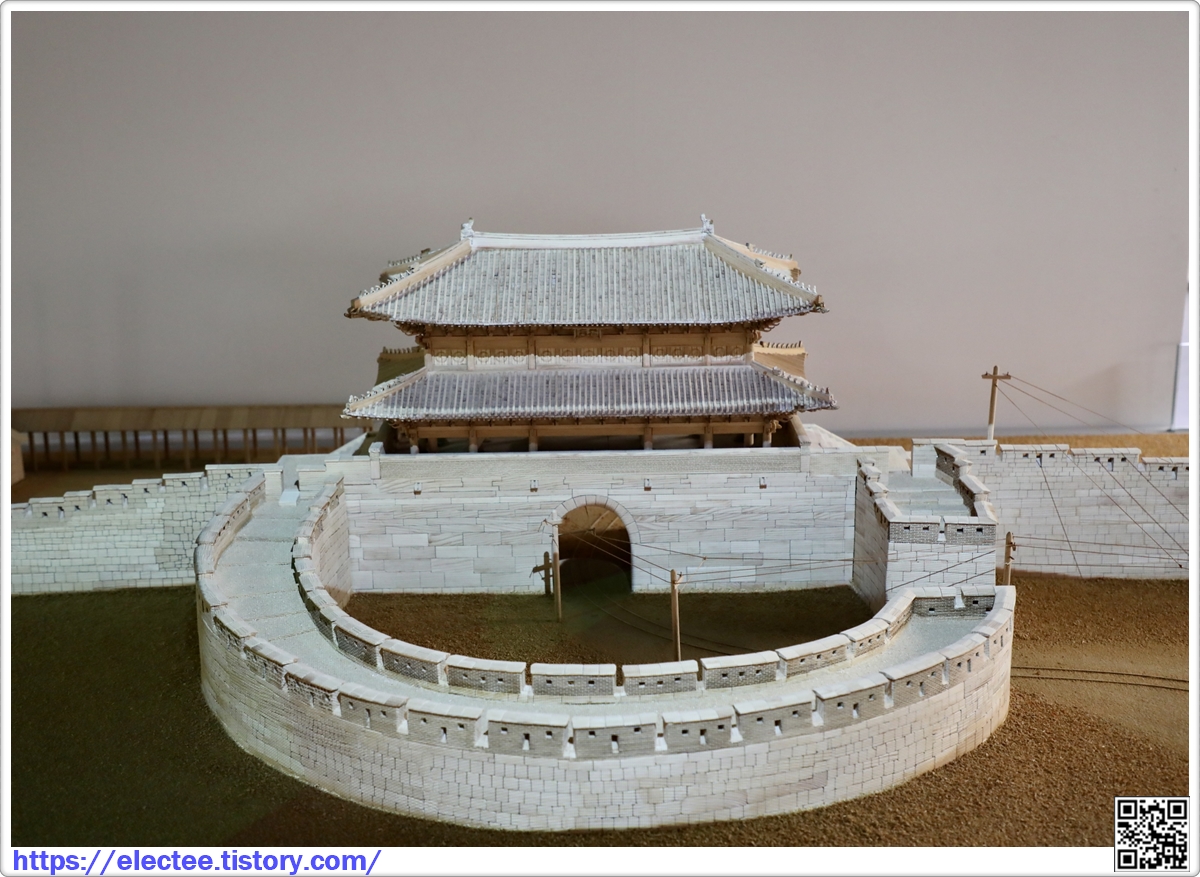
한양도성의 훼손 The Destruction of the Hanyangdoseong 汉阳都城的毁损
오래된 성곽 도시들에게 근대화란 인구 증가에 따라 도시 공간이 성벽 밖으로 팽창하고, 새로운 교통수단이
등장하여 도로가 신설 • 확장되며, 신무기 개발로 인해 성벽의 군사적 가치가 감소하는 과정이기도 했다.
전 세계 많은 도시들의 성벽이 근대화 과정에서 헐렸고 한양도성 역시 근대 도시 성곽의 운명을 피할 수 없었다.
게다가 서울의 근대 도시화는 외세의 침탈과 맞물려 있었다.
한국을 강점한 일본은 평지의 성벽을 조직적으로 허물었으며, 수백 년간 서울의 상징 구실을 한 성문들을
철거하거나 방치하였다.
일본 신토해를 사원인 조선신궁을 건립하면서 남산 일원의 성곽을 훼손했고, 경성운동장을 지으면서
동대문 주변의 성곽을 무너뜨렸다.
한양도성은 존엄한 땅을 표상하는 상징물에서 망국의 아픔을 드러내는 폐허로 바뀌었다.
"Modernization" has imposed great change on the world's ancient walled cities.
Population increases have swelled the city size beyond the walls.
New forms of transportation have been introduced and new weapons have also been developed
that nullify the defensive purpose of the walls.
Many cities around the world have torn down their walls in the process of modernization,
and the Hanyangdoseong could not avoid the fate of city walls in modern times. Moreover,
Seoul's modern urbanization occurred in tandem with plundering by outside forces.
After Japan colonized Korea, sections of capital wall on flat ground were systematically removed,
and the gates, which had been proud symbols of the capital for centuries, were either neglected
or dismantled outright.
The Hanyangdoseong was reduced from being a beacon of majesty to a ruin revealing the pain
of a fallen country.
随着近代化时期的人口剧增, 城市空间扩张到城郭之外, 新式的交通手段登场之后, 重新铺设和扩张道路,
并由于新武器的开发, 城墙的军事价值也大为降低, 这是近代古老城郭都市的历程。
全世界许多城市的城墙在近代化的过程中被拆毁, 汉阳都城也没能躲过其命运。
而且首尔的近代城市化时期, 正逢上了外势的掠夺。
强占韩国的日本计划性的拆毁了平地的城墙, 拆除或弃置了数百年间象征首尔的城门。
汉阳都城从有尊严的国士象征沦落为怀有亡国之恨的废墟。

변화의 시작 The Beginnings of Change
19세기 중후반부터 시작된 서구 열량의 개항 요구 속에서 조선 정부는'해안과 도성 경비를 강화하는 한편
경복궁과 흥인지문을 새로 짓는 등 도성을 재정비 있고 하고 왕권의 위상을 높이려 했다.
그러나 1882년 임오군란을 계기로 도성 안에 외국 군대가 주문하면서 도성의 군사적 의미는 크게 손상되었다.
또 정부의 군제 개혁으로 인해 삼군문이 해체됨으로써 일상적인 도성 관리도 허술해졌다.
도성 안은 1882년 중국 상인들에게, 1885년부터는 통상조약을 체결한 모든 나라의 상인들에게 개방되었다.
남산 기슭에서 개천에 이르는 구간은 일본인과 청국인의 거류지가 되었고, 돈의문에서 소의문에 이르는 성벽 옆
정동 일대는 서양인의 거류지가 되었다.
도성 안에 외국 공관과 종교시실, 교육시설 들이 속속 들어섰는데, 이들 중에는 성벽 바로 옆에 지은 것이 많았다.
전차가 다니는 성문 A Tram Line through the Gate
1894년 조선 정부는 국가의 법률과 제도 전반에 대한 전면적인 개혁을 단행하는 한편, 서울을 근대 국가의
수도답게 개조하는 사업도 본격화했다.
중심 대로인 종로와 남대문로 양변에 늘어서 있던 가가(假家)들을 철거하고 도로의 원래 폭을 회복하였으며,
경운궁을 새 황궁으로 정비하고, 독립문·환구단·기념비각 등 나라의 자주와 독립, 황실의 존엄을 상징하는
기념물들을 건립하였다.
1899년 돈의문에서 흥인지문을 거쳐 청량리에 이르는 노선에서 전차 운행이 시작되었고, 뒤이어 종로에서
숭례문을 거쳐 용산에 이르는 노선도 추가되었다.
전차 궤도가 숭례문과 흥인지문을 통과했기 때문에, 500여 년간 지속되어 온 이전과 파루가 중지되고
대신 정오를 알리는 오포수가 시행되었다.
성문의 실용성은 약해졌으나, 그 상징적 기능은 유지되었다.
정부는 1902년 숭례문과 돈의문 단청을 보수하는 등 도성의 체모를 지키려는 노력을 중단하지 않았다.
In 1894 the Joseon government undertook sweeping reforms of the country's laws and systems while also
undertaking a massive renovation project to give Hanyang (now Seoul) the proper appearance as the
capital of a modern state. In 1899, tram service began running from Donuimun (Gate) to Cheongnyangni
via Heunginjimun (Gate).
Subsequently, a second tram line opened between Sung-nyemun (Gate) and Yongsan.
The tram tracks were laid through Sungnyemun and Heunginjimun, and the use of bells to announce
the opening and closing of the gates, which had been in place for more than 500 years, was replaced
by the use of a cannon to announce high noon in the capital.
The practical purpose of the gates weakened, but the symbolic function remained.
Efforts to maintain the wall continued, and in 1902, the government repainted Sungnyemun and Donuimun.
도성의 수난 Dismantling the Capital Wall
성벽처리위원회 The Wall Disposition Committee
1904년 러일전쟁을 도발한 일본은 한반도에 대규모 군대를 상륙시켜 서울을 점령하고 한국을 식민지로 삼기
위한 준비를 진행했다.
일본은 1905년 한국의 외교권을 강탈하고 시정施政 개선을 돕는다는 명목으로 내정 간섭을 본격화했다.
1907년에는 대한제국 군대를 해산시키고 고종을 강제 퇴위시켰다.
한국 정부를 장악한 일본인 관리들은 위생상의 위협을 제거한다는 명목으로 숭례문과 흥인지문 밖에 있던
연못을 매립하는 한편, 성벽 일부를 철거하려 했다.
이에 '성벽처리위원회'라는 기구가 설치되어 숭례문과 소의문, 흥인지문 부근의 성벽과 오간수문의 철책을
철거하기로 결정하고 바로 실행했다.
철거된 성벽의 부재는 도로와 건축공사의 재료로 사용되었다.
Japan went to war with Russia in 1904, and was victorious the following year, when the Japanese seized
the diplomatic rights of the Daehan Empire (the Joseon successor) and stepped up their interference in
Korean affairs.
In 1907, the military force of the Daehan Empire was disbanded and Emperor Gojong was forced to abdicate
the throne in favor of his son.
The Japanese administrators had the lotus ponds outside Sungnyemun (Gate) and Heunginjimun (Gate) filled in,
citing public health concerns, and sections of the capital wall were taken down. At this juncture,
the Wall Disposition Committee was formed, and the committee members decid ed to remove the parts
of the wall adjoining Sungnyemun and Souimun (Gate), as well as the iron gates covering the Ogansumun
(five-arched water gate) The decision was carried out immediately.
The materials from the dismantled wall sections were used in the construction of streets and structures.
사라지는 문루들 The Disappearing Gate Pavilions
1910년 8월 한일병합조약이 체결되자 조선총독부는 한성부를 경성부로 개칭하고 경기도 소속으로 삼아 수도의
지위를 박탈하고 일개 지방 도시로 격하시켰다.
1914년에는 경성부의 행정구역을 개편하여 성 밖 용산 일대를 포함시켰다.
이로써 도시의 경계를 표시하는 성벽과 성문의 기능도 사라졌다.
이어 1914년에 소의문, 1915년에 돈의문을 헐고 그 문루와 석재를 건축 자재로 매각했다.
다른 성문들을 일부러 헐지는 않았으나, 퇴락하도록 방치하여 1928년 혜화문 문루가 붕괴되었다.
1938년에는 도로를 확장한다는 명목으로 남아 있던 혜화문 육축 마저 철거했다.
민간인들이 주택을 지으면서 성벽을 훼손하는 일도 흔했다.
도성의 권위를 표시하던 성벽은 퇴락하고 허물어져 한국인들에게 망국의 아픔을 일깨우는 유적이 되었다.
The Japan-Korea Annexation Treaty was signed in August 1910, and the Government-General of Korea
proceeded to change Hanseong Prefecture to Gyeongseong Prefecture and make it part of Gyeonggido.
In the process, Gyeongseong was demoted in status from capital city to just city. In 1914, the administrative
are a of Gyeongseong was reorganized to include the Yongsan district outside the city wall, and the old city
wall and its gates lost their function as city boundary markers.
Meanwhile, Souimun (Gate) was dismantled in 1914, followed by Donuimun (Gate) in 1915. The gate
pavilions and stonework were sold off as construction materials.
The other gates were not purposely demolished, but their maintenance was neglected and they fell into
states of ruin.
The gate pavilion on Hyehwamun collapsed in 1928, and then the rest of Hyehwamun was taken down
in 1938 to make way for a street widening project. Private citizens often damaged the city walls as well
while they were building their homes.
신궁 참배로가 된 남산 성벽 Namsan Wall Section Sited for Shinto Shrine
조선총독부는 식민지 통치의 일환으로 한국인들 사이에 일본 토속 종교인 신도神道를 침투시키고자 했다.
조선총독부는 1918년 12월 일본 내각에 '조선신사 창립에 관한 청의'를 제출했으며 일본 내각은 이듬해 7월
이를 승인하고 예산을 편성했다.
제사 지낼 신은 일본 건국신화의 주신인 아마데라스 오미카미자와 한국 강점의 주역인 메이지왕으로 정했다.
1920년 한국인들이 신성시해 온 남산 성벽 아래 국사당 자리에서 기공식이 열렸고 1925년에 준공되었다.
준공 직전 일본 내각은 신사의 격을 높여 '관폐대사조선신궁'으로 개칭했다.
조선신궁과 참배로를 만드는 과정에서 주변 성벽이 대거 훼손되었다.
The Government-General of Korea, as part of its colonial Japanization poicy, sought to instill the ways
of the native Japanese Shinto religion in Korean hearts and minds.
In December 1918, the Government-General of Korea submitted a formal request to the Japanese Cabinet
to discuss the establishment of the Joseon Shinto Shrine.
The Cabinet approved the project in July of the following year, and a budget was raised, and it was
dedicated to Amaterasu-ömikami (a major Shinto deity) and Japan's Meiji Emperor (r. 1867-1912).
In 1920, ground was broken for the Joseon Shinto Shrine on the former site of the Shrine of the National
Preceptor, below the city wall on Namsan (Mountain).
Construction was completed in 1925, and much of the city wall that stood near the site was removed
in the process of building the Joseon Shinto Shrine and its approach path.
운동장에 묻힌 이간수문 Two-arched water gate Buried under a Stadium
지대가 낮고 평탄하여 방어하기 어려웠던 흥인지문과 광희문 주변에는 훈련원, 하도감, 염초청 등 여러 군사
시설이 배치되었다.
영조대에는 이 구간에 여섯 개의 치성雉城을 만들었다.
1907년 대한제국 군대가 강제 해산된 뒤 이 지역에 있던 군사시설들은 학교 연합운동회나 직공 연합운동회
등의 대규모 운동회 장소로 자주 사용되었으니, 이곳은 한국 근대 스포츠의 발상지라 할 수 있다.
고종 황제와 순종 황제의 영결식도 훈련원 터에서 거행되었다.
1926년 경성부는 일본 황태자의 결혼식을 기념하여 훈련원공원 한편에 근대적 경기장인 경성운동장을 지었다.
운동장을 지으면서 흥인지문과 광희문 사이에 남아 있던 성벽마저 파괴하고 이간수문도 헐었다.
성벽 하단부의 석재는 관중석 기초로 사용되었다.
The areas around Heunginjimun (Gate) and Gwanghuimun (Gate) are on low and flat terrain,
making defense difficult. Thus, various military installations were located there.
The military force of the Daehan Empire was forcibly disbanded in 1907, and the grounds of these facilities
were often used for large-scale sporting events for students or factory workers.
In 1926, the Gyeongseong Prefecture commemorated the wedding of the Japanese Crown Prince by
constructing the Gyeongseong Stadium, a modern sports facility, on part of the old Military Training
Administration grounds.
In the process of building the new stadium, the rest of the wall between Heunginjimun and Gwanghuimun
was demolished, and the Igansumun (two-arched water gate) was taken down.
The stone blocks at the base of the wall were used as the foundation for stadium seats.
택지 개발과 도성 훼손 Residential District Development and Capital Wall Destruction
소의문 밖 아현리, 숭례문 밖 이태원, 광희문 밖 신당리, 혜화문 밖 미아리 등지는 수백 년간 도성 사람들의
묘지였고, 1920년대까지 성벽에는 묘를 쓸 수 없는 곳과 있는 곳으로 나누는 경계선 역할이 남아 있었다.
그러나 일본 제국주의의 수탈적 농업 정책으로 인해 농촌에서 밀려난 농민들이 대거 서울로 이주하면서
1920년 대부터 서울 인구는 날로 늘어났다.
도성 안의 개천 변과 산자락은 물론 공동묘지 주변까지 가난한 사람들의 주택인 토막들이 들어찼다.
조선총독부는 인구증가에 대응하는 한편 경성을 대륙 침략을 위한 전초기지로 개발하기 위해 1936년 경성부의
면적을 대폭 확장했다.
이때를 전후하여 성 밖 묘지와 주변지역들이 새 택지로 개발되었고 성벽 주변의 도로도 확장되었다.
이 과정에서 성돌을 건축 재료로 삼은 경우도 많았다.
The exploitative agricultural policy of the Japanese Empire drove large numbers of hard-pressed
farming families from the countryside and into the capital.
As a result, the population in the capital grew constantly from the 1920s. The poor people built adobe
huts along the streams and at the base of mountains inside the capital walls as well as at the edges
of public cemeteries.
In 1936, the Government General of Korea greatly expanded the area of Gyeongseong in order to address
the population increase in the capital.
Around this time, the cemeteries outside the walls and their vicinities were developed into new residential
districts and the streets along near the city wall were widened.
Stone blocks from the city wall were often treated as building materials.
명색뿐인 고적 Ancient Remains in Name Only
조선총독부는 1930년대 이후 식민지 지배체제가 안정되었다고 판단하여 한반도 내 문화유산을 가급적
보존한다는 방침을 세웠다.
이에 1933년 '조선보물고적명승천연기념물보존'을 제정·공포하고 송례문과 흥인지문을 포함하여 212점의
건조물, 공예품 등을 조선 보물로 지정했다.
1936년에는 한양도성(당시의 경성성과)을 고적으로 추가 지정했다.
그러나 조선신궁이 있는 남산 구간은 고적 지정에서 제외했으며, 지정된 구간에 대해 서도 별다른 보존 조치를
강구하지 않았다.
경성성곽을 고적으로 지정한 뒤에도 조선총독부는 혜화문 육축과 주변 성벽을 철거했으며 민간의 성벽 훼손도
지속되었다.
그럼에도 숭례문과 흥인지문 등 한양도성의 시설물들은 자체의 빼어난 건축미로 서울을 대표하는 상징물이라는
지위를 굳게 지켰다.
일제강점기에 발행된 사진엽서나 관광 안내 책자에 이들 사진이 빠짐없이 실렸다.
The Government-General of Korea issued the order to "preserve Korean treasures, ancient remains,
famous places, and natural monuments" in 1933, and designated 212 structures, including Sungnyemun
(Gate) and Heunginjimun (Gate) as well as various arts and crafts as "Joseon Treasures."
In 1936, the Hanyangdoseong was additionally designated as "ancient remains."
However, the Namsan section, where the Joseon Shinto Shrine was located, was not included in the
"ancient remains" status, and no special preservation measures were sought for the wall sections that
were so designated.
Moreover, the Government-General of Korea proceeded to dismantle the Hyehwamun (Gate) stonework
and adjoining wall sections even after the Hanyangdoseong was named "ancient remains" and damage
to the wall by private citizens continued unabated.
흥인지문 장식 기와 잡상 Decorative Tiles of Heunginjimun
조선시대에는 주요 건물의 지붕 추녀마루 위에 용두와 여러 가지 동물 모양을 한 잡상을 올려놓았다.
이는 화재를 막고 잡귀로부터 건물을 보호한다는 주술적인 의미를 갖고 있었다.
아무 건물에나 쓸 수 없었으며, 잡상의 숫자가 많을수록 건물의 등급이 높았다.
흥인지문에는 상층 9개, 하층 8개의 잡상이 있는데, 상층의 경우 대당사부, 손행자, 저팔계, 사화상, 이귀박,
이구룡, 마화상, 삼살보살, 천산갑의 순으로 잡상을 세우고 그다음 용두를 배치하였다.
흥인지문 보수·정비 과정에서 수습된 잡상은 마화상과 삼살보살을 제외한 7종류이다.
한양도성의 성격과 가치
한양도성은 2천여 년 전부터 형성, 발전해 온 한국 축성문화의 정수가 응축된 기념비적 문화유산이다.
한양도성에는 하늘의 선을 존중하고 인간의 개입을 절제하여 자연과 인공이 조화를 이루는 도시를 건설하려 한
한국인의 철학이 담겨 있으며, 500여 년에 걸친 석재 가공 기술과 축성 기술의 발전사가 아로새겨져 있다.
한양도성은 조선의 백성이 함께 쌓은 성곽이며, 도성 인근의 주민에게 각자 지켜야 할 구간이 할당된 시설이었다.
한양도성은 자연과 하나가 되었기에, 서울이 중세도시의 틀을 깨고 현대 대도시로 팽창하는 과정에서도 전면적인
멸실을 피할 수 있었다.
그리하여 현재의 한양도성은 세계에서 가장 규모가 크고 오래된 수도성곽이다.
서울은 인구 1천만의 세계적 대도시로 팽창했으나, 도성 안의 도로 체계는 성문으로 연결되었던 옛 모습을
대체로 유지하고 있다.
한양도성은 동아시아 역사도시의 현대화 과정을 보여주는 특별한 문화유산이다.
汉阳都城是二千多年前开始形成与发展而来的, 是凝聚韩国筑城文化精髓, 具有纪念碑意义的文化遗产。
汉阳都城涵有韩国人的城市建筑哲学, 是结合自然与人工达成协调的概念,
刻有历经五百多年的石材加工技术与筑城技术的发展历史。
因为汉阳都城与自然浑然一体, 首尔在打破中世城市的框架, 扩张为现代大城市的过程当中,
避免了完全的消失。因此目前的汉阳都城是全球规模最大最久的首都城郭。
首尔发展为人口一千万的世界级大都会, 都城内部道路体系仍大体维持着以城门连接的原貌。
汉阳都城是展现东亚历史城市现代化过程的特别文化遗产。
발굴, 도성의 뿌리를 찾다 Excavating in Search of the Capital Wall Origins
한양도성의 참모습을 확인하려는 진지한 노력은 2000년대에 들어서면서 비로소 시작되었다.
1999년 주한 러시아대사관 건립 예정부지에 대한 유적 시굴조사를 시작으로 숭례문 주변, 정동 일대,
장충동 일대, 남산 백범광장 등지에서 시굴과 발굴조사가 진행되었다.
이들 조사를 통해 땅 밑에서 수백 년간 성벽을 지탱해 온 기초 부분의 실체가 드러났고,
지형과 지질에 따른 축성 기법의 차이도 확인할 수 있었다.
한양도성이 자연과 한 몸이 된 것은 성을 쌓은 사람들이 성 쌓을 자리의 자연조건에 가장 잘 부합하는
재료와 기법을 사용했기 때문이다.
지상부에서는 완전히 멸실되어 흔적조차 남지 않았던 성벽 선을 다시 찾은 것도 큰 성과였다.
10여 년간 틈틈이 진행된 발굴조사 결과, 한양도성의 완전성을 이해하고 진정성 있는 보존 방안을 마련할
수 있는 단초가 열렸다.
지하에 있는 유구 또한 한양도성의 일부라는 사실을 함께 인식하고, 보존할 방도를 찾는 것이 남은 과제이다.
Serious efforts have been underway in the 21st century to verify the original appearance of the
Hanyangdoseong in every detail.
This process started in 1999 with a preliminary survey on the site that had been designated for
the new Russian Embassy.
Subsequently, preliminary surveys and full-fledged excavations were conducted around Sungnyemun,
in parts of Jeong-dong and Jangchung-dong, and at Baek-beom Square on Namsan (Mountain).
These archeological digs uncovered the actual foundations that supported the capital wall underground
for centuries, revealing differences in wall building techniques depending on the site topography
and geological features.
They also relocated the original line in which the wall had been laid at these locations,
although the part above ground had been lost without a trace.
시민에게 열린 도성 The Capital Wall Open to the Public
1993년, 북한군 특수부대의 서울 침투 이후 25년 만에 인왕산 성벽 주변 지역에 대한 민간인 출입 금지 조치가
해제되었다.
2007년에는 숙정문과 백악 주변 성벽도 민간인에게 개방되었다.
이로써 서울 시민들은 한양도성 전 구간을 둘러보며 옛 순성놀이의 정취를 되살릴 수 있게 되었다.
2008년 동대문운동장을 철거하는 과정에서 이간수문을 비롯한 성곽 유구가, 2013년에는 회현동 남쪽의 남산
기슭에서 성벽의 판축과 기초부가 양호한 상태로 발굴되었다.
이를 토대로 장소별, 시기별 축성 기법의 차이에 대한 연구를 진척시킬 수 있었다.
한양 도성은 2012년 유네스코 세계유산 잠정목록에 등재되었으며, 2013년부터 매년 한양도성 문화제가 열린다.
한편 해방 이후 성벽 주변에 형성된 마을들도 옛 성벽의 현대적 이용 사례를 보여주는 문화유산으로 파악하여,
서울시와 마을 주민들이 함께 바람직한 보존과 관리방안을 모색하고 있다.
Sections of the Hanyangdoseong near Cheongwadae were put off limits to the public in 1968 in the wake
of the North Korean commando raid.
Public access to the Inwangsan Section was restored in 1993, followed by the Baegak Section
and Sukjeongmun in 2007.
Now the people of Seoul are free to walk the entire wall, just as the capital residents did in Joseon times.
The Hanyangdoseong was included on the UNESCO World Heritage Tentative List in 2012, a
nd the annual Seoul City Wall Cultural Festival has been held since 2013 Meanwhile,
the wall-side communities formed since Liberation have become appreciated for their cultural significance,
offering examples of how to use the ancient structure in a modern context.
The Seoul Metropolitan Government and residents work together to find the most desirable ways to
preserve and manage these neighborhoods.
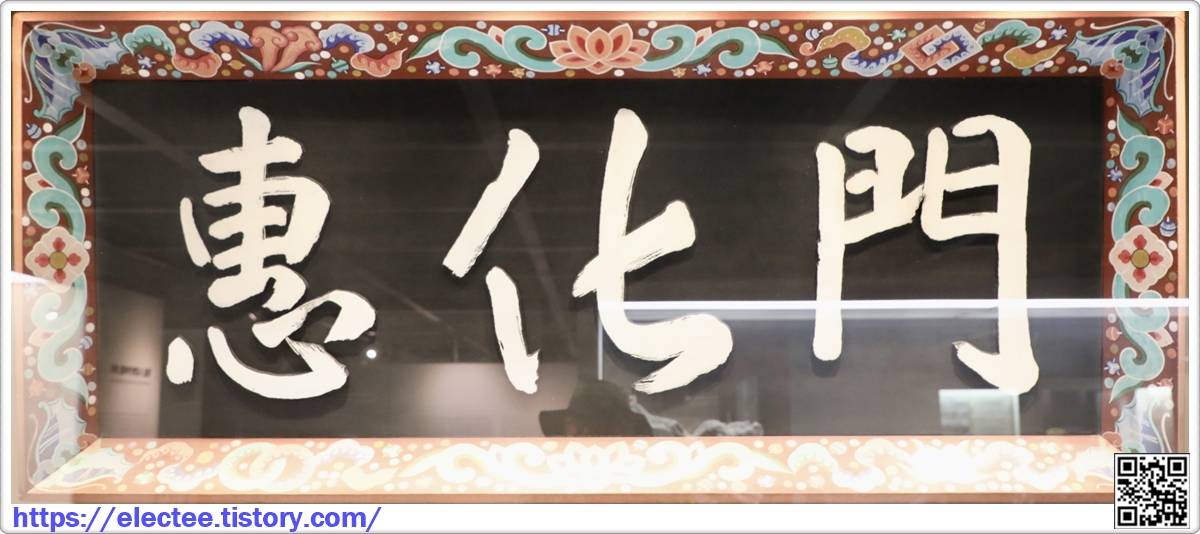
도성을 다시 쌓은 사람들 The People Who Rebuilt te Biryangdoseong
1970년대 서울성곽 정화사업'을 시작으로 한양도성 보수 · 복원 사업이 꾸준히 진행되었다.
한양도성의 보수 · 복원에는 초기 사업 계획을 수립 · 추진하는 담당 공무원부터 자문위원, 건축가, 석수,
목수, 와공 등 여러 분야의 전문가가 참여하였다.
국가 및 서울시
는 보수 복원을 위한 기본 계획 및 실행 계획을 수립하고 자격을 갖춘 문화재 전문 업체를
선정하여 보수 · 복원 사업을 진행하였다.
수립된 계획 아래 건축가는 보수 · 복원 공사를 위해 현장 실측 및 설계를 담당하고, 문화재 시공 전문 업체의
석수가 석재의 채취, 운반, 가공, 성곽 쌓기를 담당하였다.
성문과 문루 공사에는 목재를 가공하는 목수와 기와를 설치하는 와공 등이 참여하였다.
이 밖에도 보수 · 복원 공사를 감독하는 현장 감독관과 문화재 전문위원이 자문으로 참여하는 등
다양한 분야의 전문가 및 기술자가 한양도성의 보수 · 복원 사업을 수행하였다.
Numerous people contributed to the repair and restoration of the Hanyangdoseong, including the
government officials who planned and executed the project, and experts in various fields
who served as advisors, architects, stonema-sons, woodworkers, and tilers.
The national government and Seoul Metropolitan Government prepared a master plan and an action plan
for repair and restoration of the wall and selected qualified firms with expertise in cultural heritage
to execute the project.
The architect was responsible for site survey and design, and the stonemason with expertise in
cultural heritage was responsible for quarrying, transport, carving, and fixing the stones in the wall.
Woodworkers and tilers participated in the construction of gate and gate pavilion. In addition,
on-site supervisors, cultural heritage expert advisors, and other experts and technicians in various fields
participated in the repair and restoration project.
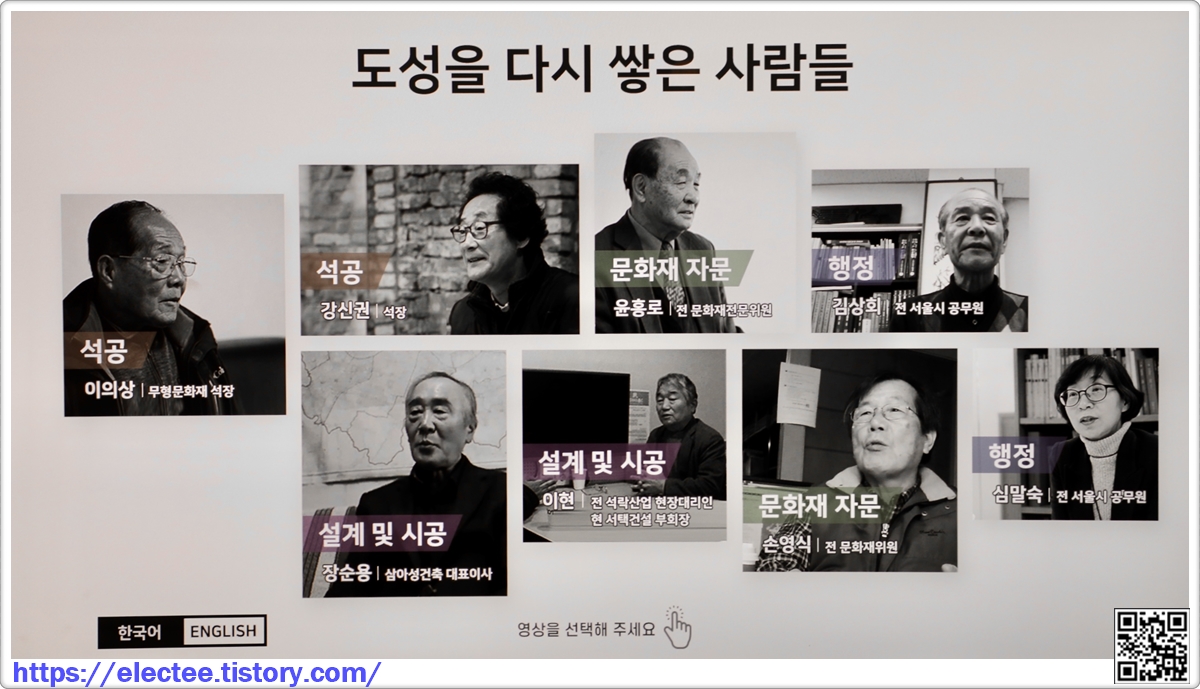
역사도시의 정체성 찾기 The Identity of a Historical
1990년대 이후 민주화와 세계화가 진전되면서 도성을 역사도시 서울의 정체성을 드러내는 핵심 구성요소로
대하는 태도가 확산되었다.
서울시는 1991년 남산 제모습 찾기 사업 과정에서 봉수대 1개소를 복원하였고, 1994년에는 혜화문을 새로 지었다.
2000년대에 들어서는 옛 도성 전체를 다시 잇고 유네스코 세계유산으로 등재한다는 구상 아래 2012년까지
멸실되거나 무너진 구간의 성벽 2.3km를 새로 쌓거나 덧쌓았다.
하지만 이 역시 재료와 기술 등 여러 면에서 전통적인 축성 방법을 따르지 않아 문화유산의 진정성을 훼손했다는
비판을 받았다.
2012년 서울시는 한양도성도감을 설치하여 유네스코 기준에 맞춰 진정성을 우선하는 새 보존 관리계획을 수립,
시행하도록 했다.
더불어 한양도성연구소와 한양도성 박물관을 신설하여 도성에 대한 연구, 홍보, 교육을 강화했다.
The democratization and globalization of Korean society progressed from the 1990s,
and the public increasingly saw the capital wall as a key structural element for expressing
the identity of Seoul as a historical city.
Between 2000 and 2012, another 2.3 kilometers of capital wall had been newly built or extended onto
existing sections as part of the effort to reconnect the entire wall and have it registered in
the UNESCO World Heritage Programme.
The Seoul Metropolitan Government formed the Seoul City Wall Division in 2012 to establish
and implement a new wall preservation and management program that puts authenticity first,
in line with the UNESCO requirements.
In addition, the Seoul City Wall Research Center and Seoul City Wall Museum were newly
opened to bolster research, PR and education activities with regard to the Hanyangdoseong.
총력안보의 상징이 된 도성 The Capital Wall as a Symbol of All-out National Security Posture
1962년 1월 문화재보호법이 제정됨에 따라 숭례문은 국보, 흥인지문은 보물, 한양 도성은 사적으로 지정되었다.
그러나 사적으로 지정된 이후에도 한동안 도성의 훼손은 지속되었다.
한양토성에 대한 인식이 바뀐 것은 1968년 1월 21일 북한군 특수부대가 서울까지 침투하여 백악 성벽 주변에서
국군과 총격전을 벌이는 사건이 발생한 뒤였다.
정부는 이 사건 직후 숙정문을 보수했으며, 1974년에는 대통령이 직점 한양도성 전 구간을 복원하여 국민의
안보의식을 고취하기 위한 교육 자료로 삼으라고 지시했다.
이에 따라 서울시에 '서울성과 복원위원회와 사울상과 복원사업추진본부 가 구성되어 멸실된 구간의 성벽을
새로 쌓고, 무너진 부분을 보수하는 공사를 시작했다.
1982년까지 9.7km를 새로 쌓으면서 성벽 뒤채움을 콘크리트로 하는 등 오히려 한양도성의 진정성을 훼손하는
문제가 발생했다.
On January 21, 1968, North Korean commandoes managed to infiltrate the Seoul City limits in their
attempt to assassinate the South Korean President.
They engaged in a gun battle with South Korean security forces near the city wall on Baegak.
Soon thereafter, the government repaired Sukjeongmun.
In 1974, the President instructed that all sections of the Hanyangdoseong be restored
and that the wall be seen as an object lesson for raising public awareness of national security matters.
As a result, the Seoul Metropolitan Government established the Seoul City Wall Restoration Committee
and the Seoul City Wall Restoration Project Promotion Headquarters, and work began on replacing
lost wall sections and repairing collapsed sections.
By 1982, a total of 9.7 kilometers of wall had been newly constructed, but problems occurred in the workmanship.
For example, the space behind the stone block face was filled with concrete instead of the original aggregate
of soil and pebbles.
축대가 된 성벽 City Wall as Retaining Wall
한양도성은 1936년 조선총독부에 의해 고적으로 지정되었으나, 도성을 소중한 문화유산으로 인식하는
사람은 많지 않았다.
더구나 해방 직후의 혼란과 전쟁을 겪으면서 피폐해진 생활과 의식, 전통문화의 가치를 평가 절하하는 태도 등은
도성 보존에 적대적인 환경을 조성했다.
민간인들이 집을 지으면서 성벽을 축대로 사용하는 일은 일반적이었고, 정부나 교육기관, 종교단체마저
성벽을 훼손하면서 건물을 짓거나 도로를 만들곤 했다.
혜화문 옆의 성벽은 고등학교의 축대가 되었고, 남산 성벽 주변에는 자유센터, 타워호텔, 외인아파트 등의
대형 건물이 건립되었다.
수많은 성돌이 이들 건물의 축대를 쌓는 데 사용되었다.
세조 때 신설되었다가 폐쇄된 남소문 터는 도로공사로 깎여 나갔으며, 광희문은 제자리에서 남쪽으로 15m
옮겨 복원되었다.
The social and political chaos immediately after Liberation and the subsequent war devastated people's
lives and changed their priorities.
The public devalued traditional culture and was not open to the ideal of preserving the capital wall.
Private citizens who built homes next to the city wall would regularly use it as a retaining wall.
The government, schools and even religious organizations would damage the city wall in the process of
building new structures or streets.
The wall next to Hyehwamun (Gate) became a retaining wall for a high school.
Large-scale projects such as the Freedom Center, Tower Hotel and apartment complex for foreign residents
were all carried out on sites in the vicinity of the Namsan Section of the city wall. Many stone blocks were
taken from the wall and used as foundation materials for these projects.
The site of Namsomun (Gate) was leveled during a street construction project, and Gwanghuimun had to be
rebuilt 15 meters south of its original location.
도성에 남은 전쟁의 상훈 Scars of War Left in the Capital Wall
1945년 8월 15일, 한국인들은 일본의 식민통치에서 해방되었지만 곧바로 자주적 정부를 세울 수는 없었다.
한동안 혼란이 지속되었고, 외국으로 나갔던 사람들이 귀환하여 서울에 정착했다.
일본인들은 물러갔으나 그보다 훨씬 더 많은 사람들이 들어왔기에 서울의 주택은 이들을 모두 수용할 수 없었다.
많은 사람들이 성벽 주변에 굴을 파거나 토막을 짓고 거주했다.
1950년 6·25 전쟁 중에는 서울역과 가까운 남산 일대에 공중 폭격이 집중되어 숭례문이 일부 파손되었고,
성벽 일부 구간은 시가전 와중에 총탄 세례를 받기도 했다.
휴전 후에는 월남민과 상경민들이 성벽을 훼손하면서 판잣집을 지었다.
현재 성벽 주변에 있는 마을들은 대개 휴전 직후에 형성되었다.
1953년부터 서울 복구 사업에 착수한 정부는 그해에 숭례문을 보수했으나, 한양도성의 전 구간을 보수할 여력은 없었다.
The Korean people were liberated from Japanese colonial rule on August 15, 1945,
but chaos continued in the country for quite some time.
Many Koreans who had left for overseas returned and settled in Seoul.
The Japanese residents were forced to leave, but far more people flooded in, creating a severe housing shortage.
Many newcomers resorted to digging pits in the area near the wall and building mud huts in which to shelter themselves. During the Korean War, the area of Namsan close to Seoul Station was heavily bombed, damaging
Sungnyemun (Gate), and a section of the city wall was peppered with small arms fire during street battles.
The government began the task of rebuilding the city in late 1953, repairing Sungnyemun that year.
However the resources were unavailable for repairing all the damaged sections of the Hanyangdoseong.
한양도성, 소생하다 Revival of the Hanyangdoseong
성벽으로 둘러싸인 중세 도시는 근대의 산업화와 도시화를 담을 수 없었다.
근대화 과정에서 성벽이 도시 발전을 방해하는 낡은 시대의 잔재로 인식된 것은 보편적인 시대 현상이었다.
전 세계 역사도시들의 성벽이 헐렸고 한양도성 역시 중세 성곽의 숙명을 피할 수는 없었다.
그러나 평지에 건설된 다른 수도 성곽들과는 달리, 한양도성은 자연과 한 몸으로 축조되었기에 많은 부분이
온존 될 수 있었다.
질풍노도와 같은 근대화의 시기를 지난 이후, 민족적 전통이 담긴 이전 시대의 유물들을 온전히 보존하고
되살려야 한다는 생각이 확산되기 시작했다.
한양도성 역시 한국과 서울의 정체성을 표현하는 기념비적 유산으로 재발견되어, 과거와는 다른 의미를 담은
구조물로 소생했다.
원 모습대로 복원하겠다는 서툰 태도가 오히려 진정성을 훼손한 사례가 적지 않았으나,
한양도성은 그 상처마저도 미래 세대에 전승할 교훈으로 풍은 채 인간과 자연, 과거와 현재가 조화를 이루는
새 시대의 표상으로 거듭났다.
In the process of modernization, city walls are universally seen as obsolete remnants from the past that
impede urban development.
The old walls in historical cities around the world have been pulled down, and the Hanyangdoseong
also was unable to escape entirely the fate of other medieval city walls.
However, the Hanyangdoseong was not built solely on flat ground as was so often the case
with other capital city walls.
Many sections managed to survive intact because the wall was built along ridge lines and blended
into the natural landscape.
Once the headlong rush to modernize has ended, people start to realize ever more strongly the need to
preserve and restore relics from previous times, steeped in national traditions.
The Hanyangdoseong, too, has been rediscovered as a landmark heritage that expresses the identity
of both Seoul and Korea as a whole, and the old wall has been revived as a structure imbued with a
new kind of significance.
한양도성의 건설 Construction of the Hanyangdoseong 汉阳都城的建设
도성은 그 위치, 규모, 형상, 격식 등을 통해 나라의 위상과 통치 이념을 드러내는 공간이자 구조물의 집적체이다.
모든 정령政令은 도성 안에서 나오며, 중요한 국가 의례는 모두 도성 안에서 이루어지고, 뛰어난 인재와 물자는
도성으로 모여든다.
1392년에 개창된 조선왕조가 새 도읍으로 정한 한양은 고려의 남경이었으나 성벽조차 없던 곳이었다.
조선왕조는 이 땅의 자연 형상을 따라 성벽을 쌓고 유교적 이상도시론에 맞추어 내부 공간을 채웠다.
도성 안의 도로는 성문을 통해 전국으로 이어졌으며, 도성 밖에 흐르는 한강은 물자 수송로로 이용되었다.
16세기말과 17세기 중엽, 일본과 청나라의 침략으로 인해 도성이 함락되고 파괴되는 피해를 입었으나,
성벽이 무너지면 다시 쌓고 성문이 퇴락하면 고쳐 지으면서 도성의 기본 구조는 조선왕조 500여 년간 큰 변화
없이 유지되었다.
The Joseon dynasty was founded in 1392, and Hanyang was selected as the site for the new capital.
A wall was built along the natural topography of the site on the layout inside the wall was organized
according to the Confucian theory of the ideal capital city.
The main streets inside the city were connected via the city wall gates to major roads that led to all parts
of the kingdom.
The Hangang (River) flowed just south of the capital, serving as a shipping route for goods.
The capital was captured and laid waste during the Japanese and Manchu invasions in the 16th and 17th century,
but the basic structure of the wall around the capital remained essentially unchanged for half a millennium.
都城通过位置, 规模, 形状, 格式等, 是呈现一国地位与统治理念的空间, 也是构筑物的总体。
1392年开创的朝鲜王朝奠定的新都汉阳, 原本是高丽王朝的南京, 是个连城墙也没有的地方。
朝鲜王朝按该自然地形筑造城墙, 并按儒家思想的理想城市论, 填满了城内空问。
都城内的道路通过城门可连接全国各地, 并利用都城南边东西流向的汉江输送物资。
16世纪末与17世纪中叶, 由于日本与中国清朝的侵略, 都城沦陷并遭到破坏, 但都城的基本结构在
朝鲜王朝五百年期间维持着原状而没有大得变化。
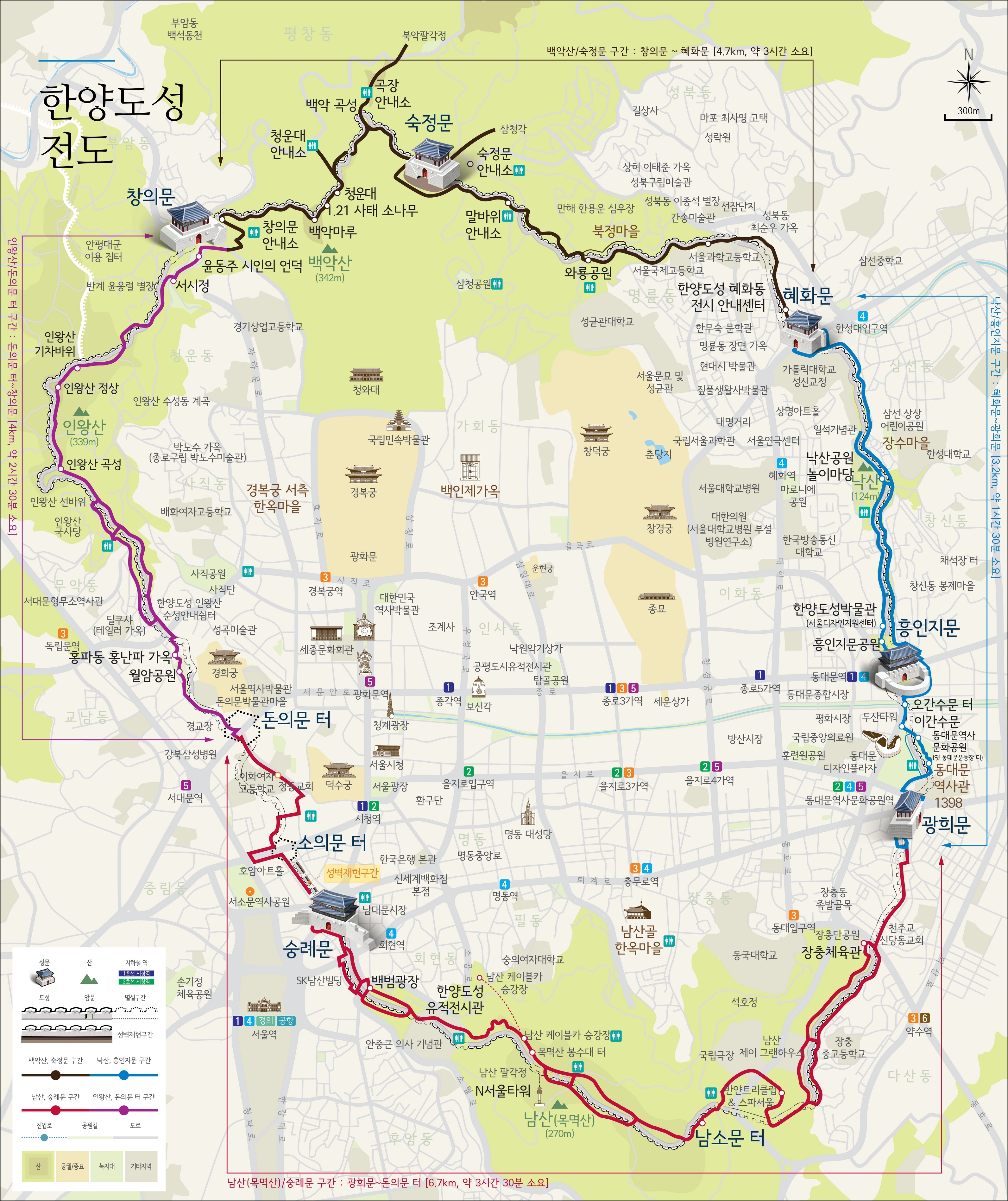
'■ 산성과 읍성 탐방 > 산성·읍성·진·보·돈대' 카테고리의 다른 글
| 국군의날에 둘러보는 청주 상당산성 (0) | 2023.10.02 |
|---|---|
| 한양도성 순성 ④ 광희문-남산-숭례문-돈의문 (0) | 2023.09.28 |
| 한양도성 「동대문 역사관」 관람 (0) | 2023.09.27 |
| 한양도성 순성 ② 백악산 구간 (0) | 2023.09.23 |
| 관악산 대타로 간 오산 독산성 (0) | 2023.09.05 |
| 복원공사가 필요한 서천읍성 (4) | 2023.08.15 |
| 고창 무장현 관아와 무장읍성은 다시 봐도 멋져 (9) | 2023.08.09 |



